Microsoft RM-8 GSM900/1800/1900 Cellular Telephone User Manual Manual
Microsoft Mobile Oy GSM900/1800/1900 Cellular Telephone Manual
Manual
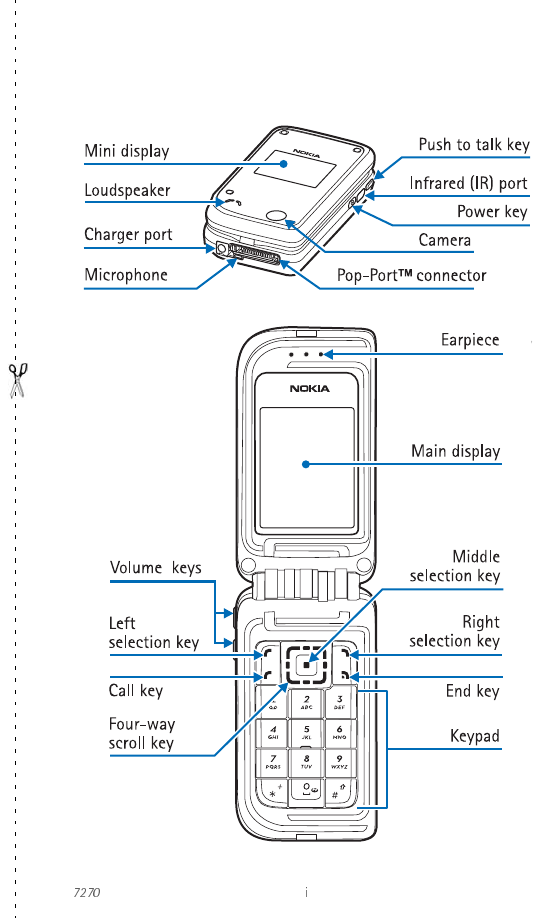
Nokia User Guide Copyright © 2004 Nokia
Nokia 7270 phone at a glance

ii Copyright © 2004 Nokia
Quick guide
Make a call Enter a phone number, and press Call.
Answer a call Press Call, or open the fold.
Answer call during call Select Answer.
End a call Press End.
Decline a call Press End.
Mute a call Select Options > Mute during a call.
Redial Press Call twice to redial the last number dialed.
Adjust call volume Press the Volume keys on the left side of the phone
during a call.
Use the in-call menu Select Options during a call.
Save a name and number Enter a number, select Save, enter a name, and select OK.
Use 1-touch dialing Press and hold a key (2–8). You must assign a key to a
number in Contacts.
Look up a name Select Contacts > Find.
Check voice mail Press and hold the 1 (contact your service provider for
details).
Write and send text
messages
Select Menu > Messages > Create message > Text
message. Enter the message, and select Send. Enter the
number, and select OK.
Send a picture message Select Menu > Messages > Create message > Text
message > Options > Insert picture. Scroll to the picture
you want, and select View > Insert. Enter the text
message, and select Send. Enter the number, and select
OK.
Read a new text message If New Message appears, select Show.

Nokia 7270 User Guide iii Copyright © 2004 Nokia
LEGAL INFORMATION
DECLARATION OF CONFORMITY
We, NOKIA CORPORATION declare under our sole responsibility that the product RM-8 is in
conformity with the provisions of the following Council Directive: 1999/5/EC.
A copy of the Declaration of Conformity can be found at
http://www.nokia.com/phones/declaration_of_conformity/
.
168
PART NO. 9233640 ISSUE NO. 1
Copyright © 2004 Nokia. All rights reserved.
Nokia, Nokia Connecting People, Pop-Port, Xpress-on, Nokia Original Enhancements, Nokia
7270, and the Nokia Original Enhancements logos are trademarks or registered trademarks of
Nokia Corporation. Other company and product names mentioned herein may be trademarks or
trade names of their respective owners.
Printed in Canada 09/2004
US Patent No 5818437 and other pending patents. T9 text input software
Copyright © 1999-2004. Tegic Communications, Inc. All rights reserved.
Includes RSA BSAFE cryptographic or security protocol software from RSA Security.
Java is a trademark of Sun Microsystems, Inc.
USE OF THIS PRODUCT IN ANY MANNER THAT COMPLIES WITH THE MPEG-4 VISUAL STANDARD
IS PROHIBITED, EXCEPT FOR USE DIRECTLY RELATED TO (A) DATA OR INFORMATION (i)
GENERATED BY AND OBTAINED WITHOUT CHARGE FROM A CONSUMER NOT THEREBY
ENGAGED IN A BUSINESS ENTERPRISE, AND (ii) FOR PERSONAL USE ONLY; AND (B) OTHER USES
SPECIFICALLY AND SEPARATELY LICENSED BY MPEG LA, L.L.C.
The information contained in this user guide was written for the Nokia 7270 product. Nokia
operates a policy of ongoing development. Nokia reserves the right to make changes to any of
the products described in this document without prior notice.
UNDER NO CIRCUMSTANCES SHALL NOKIA BE RESPONSIBLE FOR ANY LOSS OF DATA OR
INCOME OR ANY SPECIAL, INCIDENTAL, AND CONSEQUENTIAL OR INDIRECT DAMAGES
HOWSOEVER CAUSED. THE CONTENTS OF THIS DOCUMENT ARE PROVIDED "AS IS." EXCEPT AS
REQUIRED BY APPLICABLE LAW, NO WARRANTIES OF ANY KIND, EITHER EXPRESS OR IMPLIED,
INCLUDING, BUT NOT LIMITED TO, THE IMPLIED WARRANTIES OF MERCHANTABILITY AND
FITNESS FOR A PARTICULAR PURPOSE, ARE MADE IN RELATION TO THE ACCURACY AND
RELIABILITY OR CONTENTS OF THIS DOCUMENT. NOKIA RESERVES THE RIGHT TO REVISE THIS
DOCUMENT OR WITHDRAW IT AT ANY TIME WITHOUT PRIOR NOTICE.
EXPORT CONTROLS
This device may contain commodities, technology or software subject to export laws and
regulations from the US and other countries. Diversion contrary to law is prohibited.

iv Copyright © 2004 Nokia
FCC/INDUSTRY CANADA NOTICE
Your device may cause TV or radio interference (for example, when using a telephone in close
proximity to receiving equipment). The FCC or Industry Canada can require you to stop using
your telephone if such interference cannot be eliminated. If you require assistance, contact your
local service facility. This device complies with part 15 of the FCC rules. Operation is subject to
the condition that this device does not cause harmful interference.
Manufactured or sold under one or more following US Patents.
Asterisk (*) indicates design patents pending.
4868846 5519885 5827082 5966378 6112099 6266330
4969192 5526366 5835889 5970059 6115617 6282436
5001372 5553125 5839101 5987137 6118775 6285888
5045973 5557639 584884 5991716 6121846 6292668
5101175 5565821 5845219 5991857 6122498 6295286
5212834 5570369 5857151 5999523 6128322 6308084
5230091 5581244 5862178 6005857 6128509 6310609
5233634 5597102 5870683 6011853 6138091 6311054
5241284 5625274 5887266 6014573 6140966 6314166
5241583 5640395 5889770 6018277 6144243 6324412
5266782 5664004 5892475 6026161 6144676 6347218
53111 51 5664053 5898925 6028567 6148209 6356759
5311179 5669069 5907823 6029128 6151485 6359904
5317283 5677620 5914690 6038238 6151507 6363259
5331638 5678224 5914796 6043760 6163609 6370362
5335362 5692032 5915440 6047196 6164547 6370390
5353328 5699406 5917868 6049796 6167248 6377803
5378935 5699482 5920826 6050415 6170073 6393121
5384782 5701392 5926138 6055439 6178535 6430721
5390223 5729534 5926769 6060193 6185295 6434133
5396657 5729541 5930233 6069923 6188909 *29/170210
5400949 5734683 5946651 6072787 6195338 *29/170229
5416435 5754976 5956332 6081534 6199035 *29/170245
5442521 5760568 5956625 6084962 6201876 *29/170246
5444816 5782646 5956633 6088746 6219560
5446364 5794142 5960354 6094587 6240076
5479476 5802465 5960389 6097964 6240079
5487084 5805084 5963901 6105784 6249584
5493255 5805301 5966374 6108553 6259312

Nokia User Guide Copyright © 2004 Nokia
Contents
Quick guideii
1 For your safety1
About your device2
Network Services2
Shared memory3
2 About your phone4
Register your phone4
Terms4
Find information about your
phone5
Get help5
Phone introduction—fold
closed6
Phone introduction—fold
open7
Start screen8
Copyright protection11
Accessibility solutions11
Nokia PC Suite11
Connection settings service
11
Phone menus12
3 Basic operations14
Open the fold14
Install the battery and SIM
card14
Fabric wraps16
Charge the battery17
Switch the phone on and off
17
Keyguard18
Make calls18
Answer calls19
Loudspeaker20
Options during a call20
4 Text entry21
Traditional text entry21
Predictive text entry21
Tips for writing predictive or
traditional text22
5 Messages23
Linked messages23
Font size23
Text and picture messages24
Multimedia messages26
E-mail29
Instant messages (IM)32
Voice messages32
Info message service33
Service commands33
Message counter34
6 Contacts35
Menu35
Save information35
Change the primary number
37
Search for an entry37
Make a call37
Add an image to a name or
number38
Edit an entry38
Delete names and numbers38
Presence service38
Subscribed names41
Copy entries43
Business cards43
1-touch dialing44

vi Copyright © 2004 Nokia
Voice dialing44
Caller groups46
Select contacts view and
memory46
7 Call log47
Missed, received, and dialed
calls47
Positioning47
8Settings48
Profiles48
Themes49
Tone settings49
Main display settings50
Mini display settings50
Time and date settings50
Personal shortcuts51
Connectivity51
Call settings54
Phone settings57
Enhancement settings58
Configuration settings58
Security settings59
Restore factory settings63
9Gallery63
Folders63
Edit an image64
10 Media64
Camera64
Media player66
Radio67
Voice recorder68
11 Organizer70
Alarm clock70
Calendar71
To-do list73
Notes74
Synchronization74
Wallet77
Calculator80
Stopwatch81
timer82
12 Applications84
Games84
Collection85
13 Mobile Internet ser-
vices87
Set up for browsing87
Service inbox90
File download91
Disconnect from the mobile
Internet91
Make an emergency call
while online91
Options while online91
Security92
14 SIM services95
15 Hardware and en-
hancements96
Hardware96
Enhancements96
1 Reference Information
111
Battery information111
Enhancements112
Enhancements, batteries, and
chargers112

Nokia User Guide Copyright © 2004 Nokia
Care and maintenance112
Additional safety information
113
Technical information117

viii Copyright © 2004 Nokia
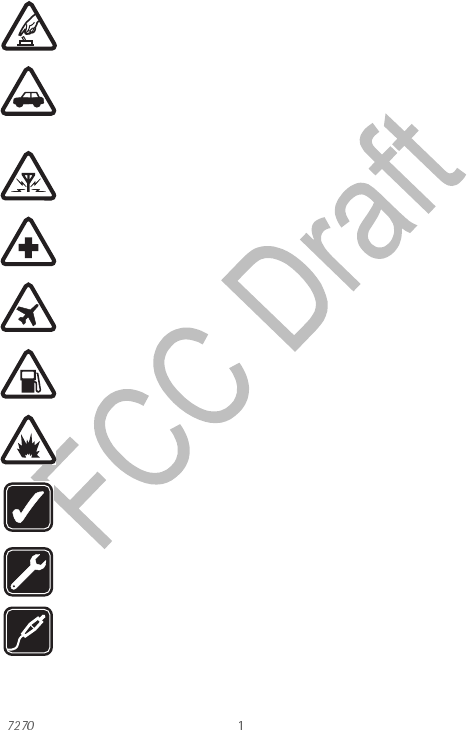
Nokia User Guide Copyright © 2004 Nokia
For your safety
1 For your safety
Read these simple guidelines. Not following them may be dangerous or illegal.
Read the complete user guide for further information.
SWITCH ON SAFELY
Do not switch the phone on when wireless phone use is prohibited
or when it may cause interference or danger.
ROAD SAFETY COMES FIRST
Obey all local laws. Always keep your hands free to operate the
vehicle while driving. Your first consideration while driving should be
road safety.
INTERFERENCE
All wireless phones may be susceptible to interference, which could
affect performance.
SWITCH OFF IN HOSPITALS
Follow any restrictions. Switch the phone off near medical
equipment.
SWITCH OFF IN AIRCRAFT
Follow any restrictions. Wireless devices can cause interference in
aircraft.
SWITCH OFF WHEN REFUELING
Don’t use the phone at a refueling point. Don’t use near fuel or
chemicals.
SWITCH OFF NEAR BLASTING
Follow any restrictions. Don’t use the phone where blasting is in
progress.
USE SENSIBLY
Use only in the normal position as explained in the product
documentation. Don’t touch the antenna unnecessarily.
QUALIFIED SERVICE
Only qualified personnel may install or repair this product.
ENHANCEMENTS AND BATTERIES
Use only approved enhancements and batteries. Do not connect
incompatible products.
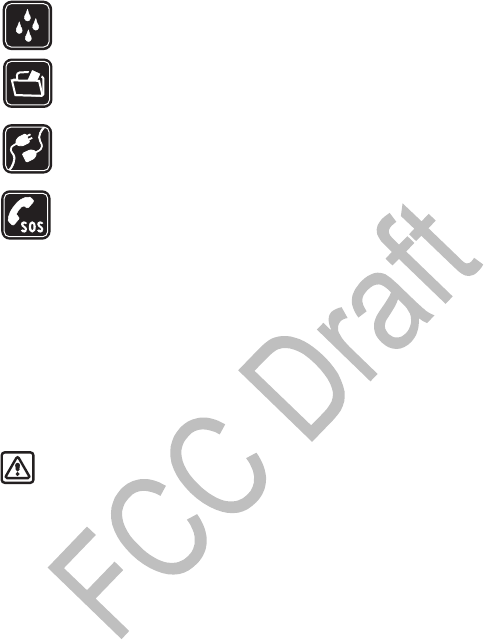
2 Copyright © 2004 Nokia
WATER-RESISTANCE
Your phone is not water-resistant. Keep it dry.
BACK-UP COPIES
Remember to make back-up copies or keep a written record of all
important information stored in your phone.
CONNECTING TO OTHER DEVICES
When connecting to any other device, read its user guide for
detailed safety instructions. Do not connect incompatible products.
EMERGENCY CALLS
Ensure the phone is switched on and in service. Press End as many
times as needed to clear the display and return to the main screen.
Enter the emergency number, then press Call. Give your location. Do
not end the call until given permission to do so.
• About your device
The wireless device described in this guide is approved for use on the EGSM
900 MHz and the GSM 1800 and 1900 MHz network. Contact your service
provider for more information about networks.
When using the features in this device, obey all laws and respect the privacy
and legitimate rights of others.
Warning: To use any features in this device, other than the alarm clock,
the phone must be switched on. Do not switch the device on when
wireless phone use may cause interference or danger.
• Network Services
To use the phone you must have service from a wireless service provider. Many
of the features in this device depend on features in the wireless network to
function. These Network Services may not be available on all networks or you
may have to make specific arrangements with your service provider before you
can utilize Network Services. Your service provider may need to give you
additional instructions for their use and explain what charges will apply. Some
networks may have limitations that affect how you can use Network Services.
For instance, some networks may not support all language-dependent
characters and services.
Your service provider may have requested that certain features be disabled or
not activated in your device. If so, they will not appear on your device menu.
Contact your service provider for more information.

Nokia User Guide Copyright © 2004 Nokia
For your safety
• Shared memory
The following features in this device may share memory: contacts, text and
multimedia messages, instant messaging, e-mails, voice tags, images, ringing
tones, video clips, sound clips, camera, calendar, to-do notes, notes, and Java™
games and applications. Use of one or more of these features may reduce the
memory available for the remaining features sharing memory. For example,
saving many gallery items may use all of the available memory. Your phone may
display a message that the memory is full when you try to use a shared memory
feature. In this case, delete some of the information or entries stored in the
shared memory features before continuing. Some of the features may have a
certain amount of memory specially allotted to them in addition to the memory
shared with other features.
Refer to the appropriate area of this User Guide for information on how to
manage the features and data in your device.
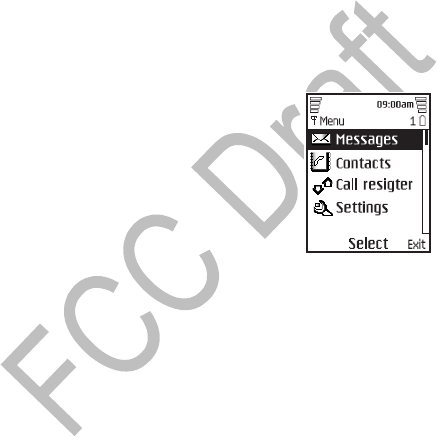
4 Copyright © 2004 Nokia
2 About your phone
Congratulations on your purchase of the Nokia 7270 mobile phone.
• Register your phone
Be sure to register your phone at www.warranty.nokiausa.com or call
1-888-NOKIA-2U (1-888-665-4228) so that we can serve you better if you
need to call a customer center or to have your phone repaired.
•Terms
This guide uses certain terms for the parts of the phone and the steps that you
are asked to perform.
•Highlighted options on the screen are enclosed
within a bar. The selection keys are used to act on
the highlighted option.
•Left selection key and Right selection key are
used to select the options on the left and right
bottom corners of the screen.
•Four-way scroll and Middle selection key is used
to navigate through names, phone numbers,
menus, and settings. It is also used to move the
cursor up, down, left, and right when writing text,
using the calendar, and in some game applications. Pressing the key briefly
in the center selects the item in the bottom center of the screen. The center
of the Four-way scroll is also called the Middle selection key. The top,
bottom, left, and right edges of the Four-way scroll are also called the
Scroll up, Scroll down, Scroll left, and Scroll right keys.
•Select means to press the Left selection key or the Right selection key, or
to press the center of the Four-way scroll (the Middle selection key). To
select an option, press the selection key below the menu item on the phone
screen.
•Call and End keys. Press Call to place a call or to answer an incoming call.
Press End to end a call or to return to the start screen.
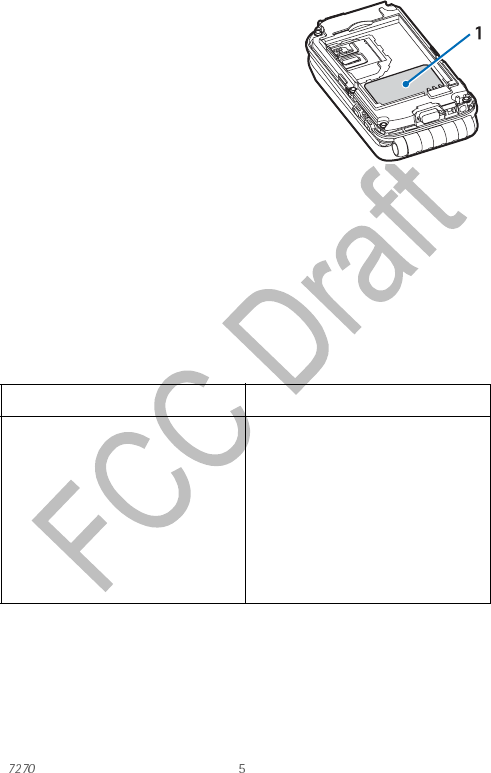
Nokia User Guide Copyright © 2004 Nokia
About your phone
• Find information about your phone
The information label (1), under the battery,
contains the following information:
• Model number
• Phone type and FCC ID
• International mobile equipment identity
(IMEI)
•Get help
If you need help, Nokia Customer Care is
available for assistance. We recommend that you write down the following
information and have it available if you call.
• The IMEI printed on the back of the phone, beneath the battery
• Your zip code
Contact Nokia
Please have your phone or enhancement with you when contacting the numbers
below.
Contact your service provider
To use the network services available in your phone, you will need to sign up
with a service provider. In many cases, the service provider will make available
descriptions of their services and instructions for using certain features.
Nokia Customer Care Center, USA Customer Care, Canada
Nokia Inc.
7725 Woodland Center Boulevard
Suite 150
Tampa, Florida 33614
Tel: 1-888-NOKIA-2U
(1-888-665-4228)
Fax: 1-813-249-9619
TTY: 1-800-24-NOKIA
(1-800-246-6542)
Nokia Products Ltd.
601 Westney Road South
Ajax, Ontario L1S 4N7
Tel: 1-888-22-NOKIA
(1-888-226-6542)
Fax: 1-905-619-4360
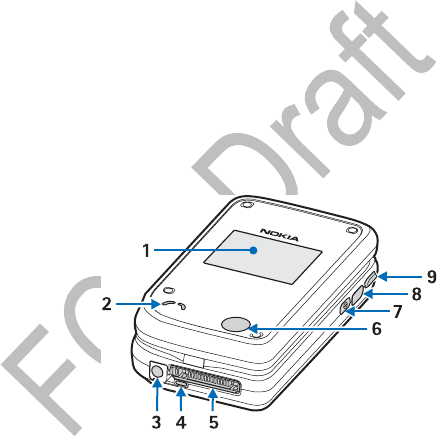
6 Copyright © 2004 Nokia
Service providers may differ in their support of features. Before you sign up,
make sure a service provider supports the features that you need.
Guide updates
From time to time, Nokia updates this guide to reflect changes. The latest
version may be available at www.nokia.com/us.
Online tutorials
An interactive tutorial for this product may be available at the Web site
www.nokiahowto.com.
In-phone help
Many features have brief descriptions (help text) that can be viewed on the
display. To view help text, scroll to a feature and wait for about 15 seconds for
the help text to appear.
The default setting for help text is On. To activate or deactivate help text:
Select Menu > Settings > Phone settings > Help text activation > On or Off.
• Phone introduction—fold closed
• Mini display (1)
• Loudspeaker (2)
• Charger
connector (3)
• Microphone (4)
• Pop-Port™
connector (5)
used for
headsets and
the data cable.
• Camera lens (6)
•Power key (7)
switches the
phone on and off.
When the keypad is locked, press the Power key briefly to turn the display
lights on for approximately 15 seconds.
• Infrared (IR) port (8)
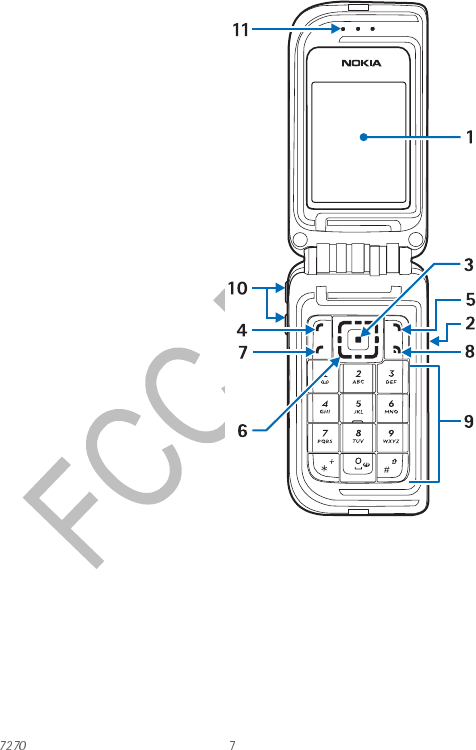
Nokia User Guide Copyright © 2004 Nokia
About your phone
• Phone introduction—fold open
• Main display (1)
• Power key (2)
•Left, middle, and right
selection keys (4), (3), and (5)
The function of these keys
depends on the guiding text
shown on the display above the
keys. See “Main display” on
page 8.
•Up, down, left, and right
scroll keys (6)
Use to scroll through contacts,
menus, settings, calendar
dates, and feature options, or
to move the cursor when
writing text.
•Call key (7) dials a phone
number, and answers a call.
•End key (8) ends an active call,
and exits from any function.
•Number keys (9) enter
numbers and characters; *
and # keys are used for
various purposes depending
on the function.
•Volume keys (10) adjust the
earpiece, the loudspeaker, or
the headset volume (it is
connected).
When the fold is closed, use
the volume keys to mute the
ringing tone of an incoming
call, to switch the alarm clock
to snooze, or to mute.
• Earpiece (11)
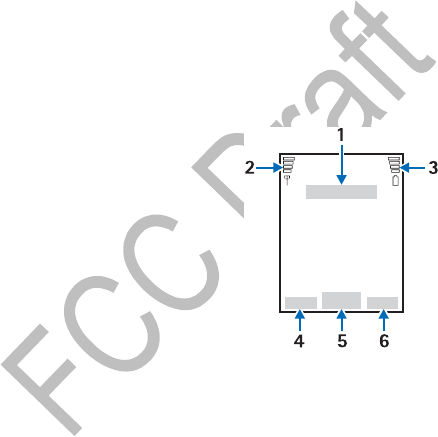
8 Copyright © 2004 Nokia
• Start screen
When the phone is ready for use, and you have not keyed in any characters, the
phone is in the start screen.
Mini display
When the fold is closed, the mini display may show the following information:
• The signal strength of the cellular network at your current location, and
the battery charge level
• The name of the network or a text note indicating that the phone is not in
service
• The time and date, the active profile, and the alarm clock or calendar note
alerts
• The caller’s name or number of an incoming call and the caller, if identified
Main display
• Name of the network or the operator
logo to indicate in which cellular
network the phone is currently being
used (1)
• Signal strength of the cellular network
at your current location (2). The higher
the bar, the stronger the signal.
• Battery charge level (3). The higher the
bar, the more charge in the battery.
• The Left selection key (4) in the start
screen is Go to.
Select Go to to view the list of functions
that are in your personal shortcut list.
Select any function to activate it, or select Options to access the following
options:
Select options—View the list of all available functions. Select a function,
and Mark to add it to the shortcut list. To remove a function from the
shortcut list, select Unmark. If there are no functions on the shortcut list,
select Add to add a function.
Organize—Rearrange the functions on the list. Select the function you
want to move, then select Move and one of the moving options.
• The Middle selection key (5) in the start screen is Menu.
• The Right selection key (6) in the start screen may be:

Nokia User Guide Copyright © 2004 Nokia
About your phone
Names—to access the Contacts menu
The operator-specific key—to access an operator’s homepage
Personal shortcut—a specific function for the Right selection key menu.
See “Personal shortcuts” on page 51.
Screen saver
You can select an image for the screen saver on the mini display, and set the
phone to activate it after a certain length of time if no phone function is used.
See “Mini display settings” on page 50.
The phone automatically activates the digital clock screen saver on the main
display in the start screen, and also on the mini display if you have not selected
a screen saver for it. If you have not set the time, 00:00 is displayed.
Shortcuts in the start screen
• To access the list of dialed numbers, press Call. Scroll to the desired
number, and press Call to dial the number.
• To call your voice mailbox when you have saved your voice mailbox
number in the phone, press and hold 1.
• To connect to a browser service, press and hold 0.
• To open the PPT group list, scroll right.
• To find a name in the contacts list, scroll down.
• To write a text message, scroll left.
• To open the camera viewfinder in standard photo view, scroll up. To change
to video, scroll left. To change to portrait photo, scroll right.
• To select a profile when the keypad is unlocked, briefly press the Power key,
scroll to the desired profile, and press and hold the Power key.
Indicators and icons
Icon Indicates...
You have one or more text or picture messages.
See “Read a message” on page 25.
You have one or more multimedia messages.
See “Read and reply” on page 28.
You have one or more voice messages.
See “Voice messages” on page 32.
You have a delivery note, sent by your network, in the inbox.
See “Settings” on page 24.
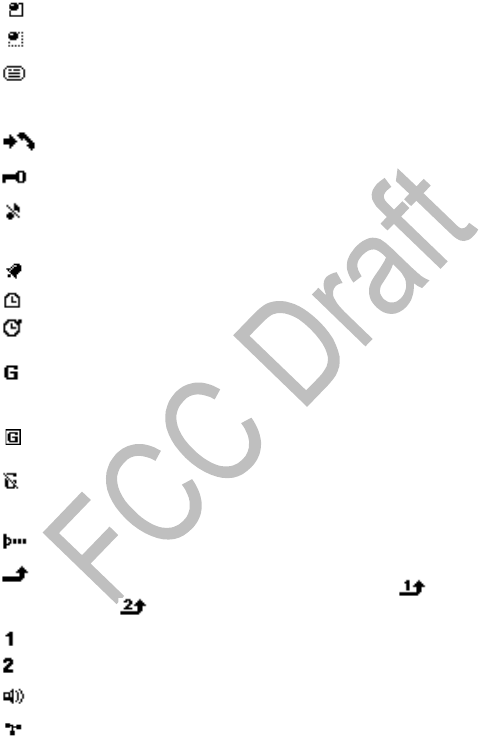
10 Copyright © 2004 Nokia
or Your phone is connected to an instant message service, and the
availability status is online or offline.
See “Instant messages (IM)” on page 32.
Your phone is connected to an instant message service ,and you
have received one or more instant messages.
See “Instant messages (IM)” on page 32.
The phone has registered a missed call.
See “Call log” on page 47.
Your phone keypad is locked. See “Keyguard” on page 18.
Your phone does not ring for an incoming call or text message
when Incoming call alert is set to Off and Message alert tone is
set to Off. See “Customize a profile” on page 48.
The alarm clock is set to On. See “Alarm clock” on page 70.
The timer is running. See “timer” on page 82.
The stopwatch is running in the background.
See “Stopwatch” on page 81.
The GPRS connection mode Always online is selected, and the
GPRS service is available. The indicator is shown on the top left of
the display. See “GPRS modem settings” on page 53.
A GPRS dial-up connection is established. The indicator is shown on
the top left of the display. See “GPRS modem settings” on page 53.
The GPRS dial-up connection is suspended. For example, you have
an incoming or outgoing call during a GPRS connection. The
indicator is shown on the top right of the display.
IR connection indicator. See “Infrared” on page 52.
Forward all voice calls. All calls are forwarded to another number.
If you have two phone lines, the indicator for line 1 is and
for line 2 .
or If you have two phone lines, this indicator displays the selected
phone line. See “Phone settings” on page 57.
Loudspeaker is active. See “Loudspeaker” on page 20.
Calls are limited to a closed user group.
See “Closed user groups” on page 61.
Icon Indicates...

Nokia User Guide Copyright © 2004 Nokia
About your phone
• Copyright protection
Copyright protections may prevent some images, ringing tones, and other
content from being copied, modified, transferred, or forwarded.
• Accessibility solutions
Nokia is committed to making mobile phones easy to use for all individuals,
including those with disabilities. For more information, visit
www.nokiaaccessibility.com.
• Nokia PC Suite
Nokia PC Suite is a collection of powerful software tools that let your phone work
with a compatible PC to manage phone features and data. For more information,
consult the Nokia PC Suite online help.
Nokia PC Suite software and documentation can be downloaded from the
www.nokia.com/us.
• Connection settings service
To use browsers, MMS, GPRS, and other wireless services, you must have the
proper connection settings on your phone. Your service provider may be able to
send the settings directly to you as a connection settings message. You only
need to save the settings on your phone. For more information about the
availability of the settings, contact your service provider or nearest authorized
Nokia dealer.
You may be able to receive the connection settings for multimedia messages,
e-mail, IM and presence, streaming, and the browser.
The timed profile is selected. See “Profiles” on page 48.
or Voice privacy encryption is active (or not active) in the network.
,
or
A headset, hands-free, loopset, or music stand enhancement is
connected to the phone.
Icon Indicates...

12 Copyright © 2004 Nokia
If you receive the connection settings as a message and the settings are not
automatically saved and activated, Connection settings received is displayed.
You can do one of the following:
• To save the received settings, select Save. If Enter settings’ PIN is
displayed, enter the PIN code for the settings, and select OK. For the PIN
code, contact the service provider that supplies the settings.
If no settings have been saved yet, the settings are saved and set as default
configuration settings. Otherwise, the phone asks Set as default settings?.
• To discard the received settings, select Discard.
You may need to activate the settings as described in the section for that
service.
You can also find the settings in the support section of www.nokia.com/us.
• Phone menus
Phone features are grouped according to function and are accessed through the
main menus of your phone. Each main menu contains submenus and lists from
which you can select or view items and customize phone features.
Note: Some features may not be available, depending on your network.
For more information, contact your service provider.
You can choose from two types of menu style: List and Grid. See “Main display
settings” on page 50 or “Scroll method” on page 13 to switch between styles.
In the List style, the menu names are listed in the conventional way. In the Grid
style, multiple menu icons appear on a single display.
You can use menus and submenus by scrolling or by using a shortcut.
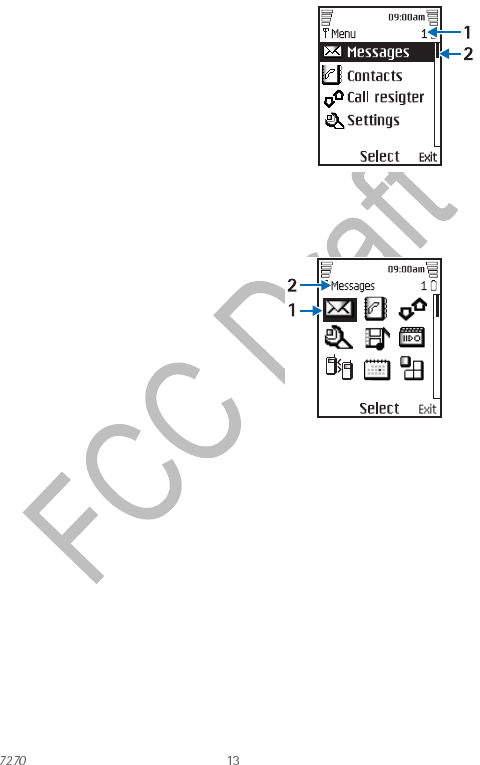
Nokia User Guide Copyright © 2004 Nokia
About your phone
Scroll method
1At the start screen, use the Middle selection key to select Menu.
2In the List view, scroll through the main
menus one at a time using the Scroll up
key and the Scroll down key.
3As you scroll through the menus, the
menu number (1) appears in the upper
right corner of the display. Below the
menu number is a scroll bar with a tab (2).
The tab moves up or down as you scroll
through the menus, providing a visual
representation of your current position in
the menu structure.
4To change between the List and Grid view, select Settings > Main display
settings > Menu view > List or Grid.
5In the Grid view, use all four scroll keys
to navigate through the menu icons.
The icon for the selected menu is
highlighted (1), and the name (2) of the
menu appears at the top of the display.
6When the desired menu is highlighted,
press the Middle selection key.
7If the menu contains submenus, use the
scroll keys to highlight the desired
menu; then press the Middle selection
key.
•Select Back (press the Right selection
key) to return to the previous menu or submenu.
• Press End to return to the start screen from any main menu.
Shortcuts
Menus and options are numbered so that you can quickly key–press your way
to an option. The numbers appear in the top right corner of the screen and show
your location in the menu.
Select Menu, and within 1.5 seconds, enter the first number of the menu
function you want to access. Repeat until you have entered all the numbers.
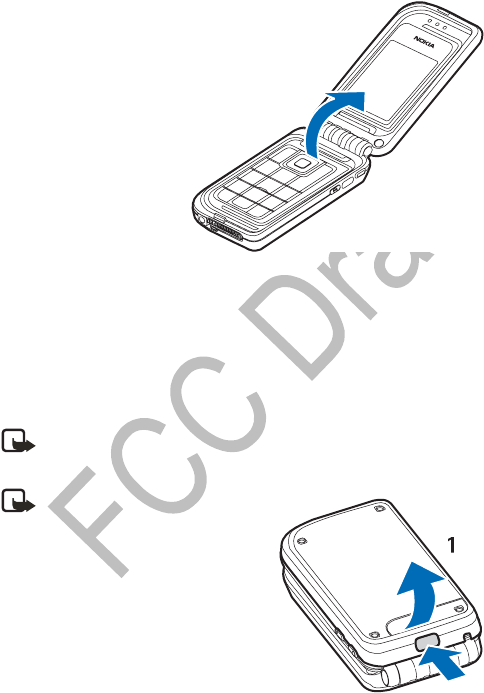
14 Copyright © 2004 Nokia
3 Basic operations
• Open the fold
When you open the fold of
the phone, it automatically
opens to about 150 degrees.
Do not try to force the fold
open further.
• Install the battery and SIM card
Keep all SIM cards out of the reach of small children. For availability and
information on using SIM card services, contact your SIM card vendor. This may
be the service provider, network operator, or other vendor.
The SIM card and its contacts can easily be damaged by scratches or bending,
so be careful when handling, inserting, or removing the card.
Note: Before installing or removing the battery or SIM card, always
ensure that the phone is switched off and disconnected from any
enhancement.
Note: Avoid touching electronic
components while changing
cover. Store and use your device
with its covers attached.
1With the phone closed and the back
of the phone facing you, press the
release button and lift the cover to
remove it from the phone.
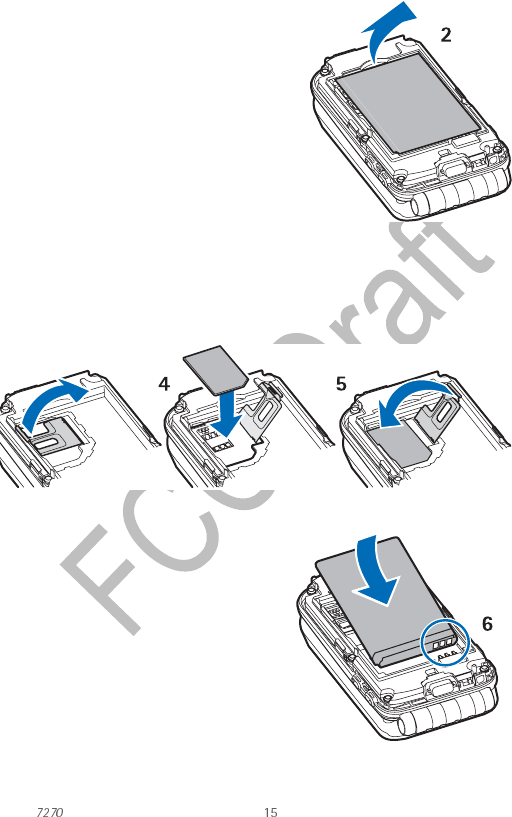
Nokia User Guide Copyright © 2004 Nokia
Basic operations
2Remove the battery.
3To open the SIM card holder, gently
pull up on the locking clip.
4Insert the SIM card into the SIM card
holder so that the gold-colored
contact area on the card is facing
downwards. Ensure that the SIM card is properly inserted.
5Close the cover of the SIM card holder, and press it gently to snap into
place.
6Replace the battery, being sure
that the battery terminals are in
the proper position.
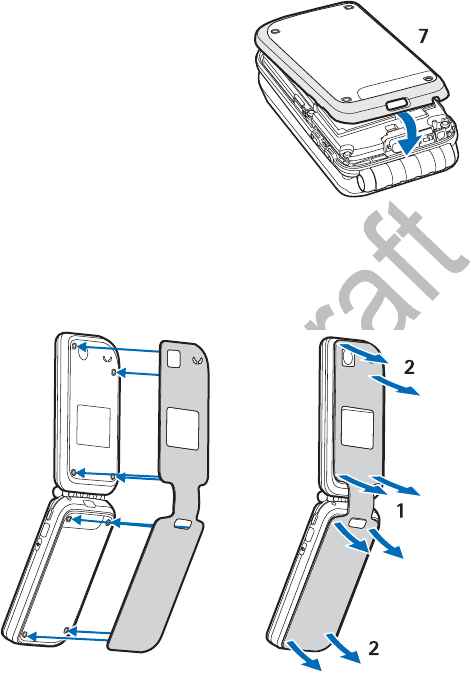
16 Copyright © 2004 Nokia
7Slip the locking catches of the
cover into the mating catches on
the phone; then press the opposite
end of the cover down onto the
cover release button until it snaps
into place.
•Fabric wraps
You can personalize your phone with replaceable fabric wraps.
To insert a new wrap, fasten the wrap to the phone cover according to the
picture.
To remove the wrap, first loosen it from both sides of the hinge (1), then from
the ends of the phone (2).
To clean the fabric, remove the wrap and wipe them with a slightly damp cloth.
In the case of stains, use a mild soap or detergent. Dry the covers thoroughly.
Once the covers are completely dry, place them back on the phone.
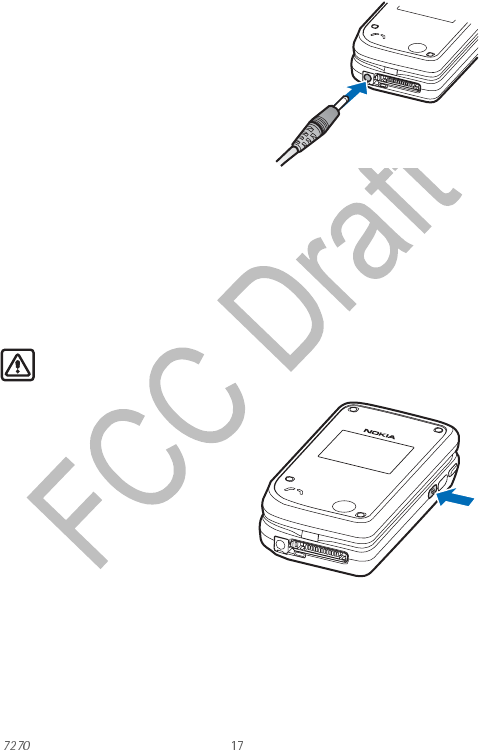
Nokia User Guide Copyright © 2004 Nokia
Basic operations
• Charge the battery
1Connect the charger to a wall socket.
2Connect the lead from the charger to
the socket on the bottom of your
phone.
On the main display the battery
indicator scrolls during charging. If
the power is on, the word Charging
appears briefly when the charger is
first attached. If the battery is
completely discharged, it may take a
few minutes before the charging
indicator appears on the display or
before any calls can be made.
You can use the phone while the charger is connected.
The charging time depends on the charger used, the battery used, and the
charge on the battery.
• Switch the phone on and off
Warning: Do not switch the phone on when wireless phone use is
prohibited or when it may cause interference or danger.
To switch the phone on or off,
press and hold the Power key.
If the phone displays Insert SIM card
even though the SIM card is properly
inserted, or SIM card not supported,
contact your network operator or
service provider. Your phone does not
support 5-V SIM cards.
If the phone requests a PIN code or a
security code, enter the code, and
select OK. See also “Access codes” on
page 62.
Hold the phone as you would any other telephone.
Your phone has an internal antenna.
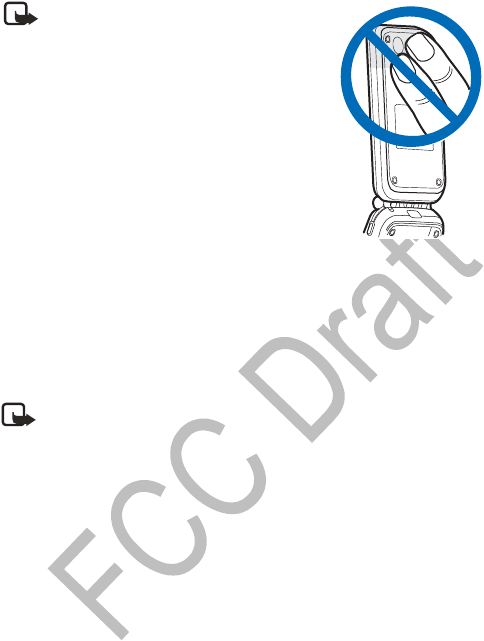
18 Copyright © 2004 Nokia
Note: As with any other radio transmitting
device, do not touch the antenna area
unnecessarily when the device is switched
on. Contact with the antenna area affects
call quality and may cause the phone to
operate at a higher power level than
otherwise needed. Avoiding contact with
the antenna area when operating the phone
optimizes the antenna performance and the
battery life.
•Keyguard
With keyguard, you can lock the keypad to prevent
keys from being pressed accidentally. See “Security keyguard” on page 57.
If the keypad is locked, it unlocks when you receive a call. After a call, the lock
automatically reactivates.
To lock the keypad, at the start screen, select Menu > *.
To unlock the keypad, at the start screen, select Unlock > *, and enter the
security code if required.
When keyguard is on, calls may be possible to the emergency number
programmed into your phone (for example, 911). Key in the emergency
number, and press Call. The number is displayed only after you have
keyed in its last digit.
• Make calls
Use the keypad
1Open the fold, enter the phone number (including the area code), and press
Call.
To delete a character to the left of the cursor, select Clear.
2To end the call or to cancel the call attempt, press End.
Use contacts
1At the start screen, scroll down; then scroll to the entry you wish to view.
To search the list of entries quickly, press the key with the letter that
matches the first letter of the contact name.
2Press Call to make the call, or select Details to view details of the entry.

Nokia User Guide Copyright © 2004 Nokia
Basic operations
Use 1-touch dialing
Before using 1-touch dialing, you must assign a phone number to a key (2–9). See
“1-touch dialing” on page 44.
If 1-touch dialing is set to On in the call settings, press and hold the assigned
1-touch dialing key until the call is started.
• Answer calls
When you receive a call, the phone shows the caller’s name, phone number, or
displays Private number or Call. The information appears in the mini display if the
phone is closed, or in the main display if the phone is open.
To answer a call, press Call. See “Answer when fold is open” on page 55 for another
method.
To reject a call, open the fold and quickly close it again. If the fold is already open,
press End to reject the call. If Forward if busy is activated on your voice mailbox,
the call is forwarded to your voice mail. If not, the call is rejected.
If you select Silence, only the ringing tone is muted. You can still answer or reject
the incoming call.
If a compatible headset with a headset key is connected to the phone, you can
answer or end a call by pressing the key on the headset.
Call waiting
During a call, press Answer or Call to answer the waiting call. The first call is put
on hold. Press End to end the active call.
To activate call waiting, see “Call waiting” on page 56.
Answer a call with the keys locked
To answer a call with keyguard on, open the fold or press Call. During the call, all
features function as normal. When you end or reject the call, the keypad
automatically relocks.

20 Copyright © 2004 Nokia
• Loudspeaker
You can use your phone as a loudspeaker during a call. Do not hold the phone to
your ear during the loudspeaker operation.
Warning: Do not hold the device near your ear when the loudspeaker is in
use because the volume may be extremely loud.
To activate the loudspeaker, select Loudsp; to deactivate it, select Normal.
To activate a headset, if attached, select Loudsp > Heads.
The loudspeaker is deactivated automatically when a call (or a call attempt) ends
or when certain enhancements are connected.
• Options during a call
Many of the options that you can use during a call are network services. To check
availability, contact your network operator or service provider.
During a call, you can select Options to access the available options. Some of the
options are:
Hold—Put a call on hold.
Mute—The caller will hear silence.
Contacts—Access your contacts list.
New call—Place a new call; the first call is put on hold (network service).
Menu—Display the main menus.
Lock keypad—Lock the keypad to prevent an accidental key press.
Record—Record the call. See “Record a phone call” on page 68.
End call—End a call.
Touch tones—Send touch tones generated by your phone keypad. Enter the touch
tone string or search for it in contacts, and select Tones.
Loudspeaker—Listen to the call on the loudspeaker.
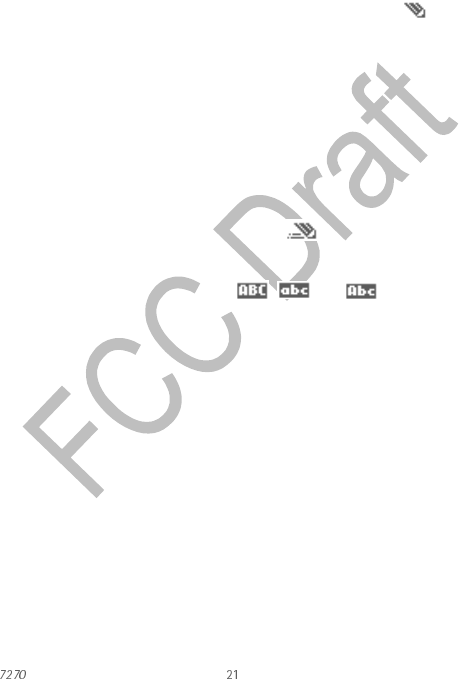
Nokia User Guide Copyright © 2004 Nokia
Text entry
4 Text entry
You can use two methods for entering text and numbers.
• Traditional text entry
Traditional text entry (predictive text off) is the only way to enter names into
contacts and to rename caller groups. In standard mode, the icon appears in
the upper left corner of the display.
Press a key once to insert the first letter on the key, twice for the second letter, etc.
If you pause briefly, the last letter in the display is accepted and your phone awaits
the next entry.
To insert a name from the contacts list, select Options > Insert contact, and the
contact to insert.
• Predictive text entry
Predictive text entry (predictive text on) is a quick and easy method for writing
messages. When predictive text is on, the icon appears in the upper left
corner of the display.
Press # to switch between traditional text entry, predictive text entry, uppercase ,
lowercase, and sentence case. The icons , , and appear in the upper
left of the display indicating uppercase, lowercase, and sentence case.
To switch to numeric entry, press and hold #; then select Number mode. To switch
back to text entry, press and hold #, and select Writing language.
Activate predictive text
At a text entry screen, select Options > Predictive text and the desired language.
The selection of a writing language does not affect the language used in the phone
menus, displays, and messages.
Enter text
• For each letter of the word that you want to spell, press the corresponding key
on your keypad only once, even if the letter you want is not the first letter on
the key. The phone guesses the word you are trying to spell.
• If a displayed word is not correct, press * repeatedly to see other matches.
• Press 0 to accept the word; then begin writing the next word.
• To insert a word, select Options > Insert word, write the word using

22 Copyright © 2004 Nokia
traditional text input, and Save. The word is added to your message and to the
dictionary.
Compound words
Enter the first part of the word and scroll right to confirm it. Enter the last part of
the word and confirm it by pressing 0.
Add new words to the dictionary
If you encounter a word that predictive text does not recognize, a question mark
(?) follows the word and Spell appears in the bottom center of the display.
Select Spell, enter your new word using the keypad, and select Save. The word is
added to the dictionary and to the message that you are writing. When the
dictionary is full, the most recent addition replaces the first.
• Tips for writing predictive or traditional text
• Press 0 to enter a space, and press 1 to enter a period (.).
• To move the cursor left or right, scroll left or right.
• To delete a character, select Clear. Select and hold Clear to continuously delete
characters. Select Options > Clear text to delete all of the characters at once
when writing a message.
• To switch between upper and lower case, or between traditional and predictive
text, press # repeatedly and check the indicator at the top of the display.
• To switch between letters and numbers, press and hold #, and select the
desired mode.
• To enter a number, press and hold the desired key.
• To display special characters, press *. (Press and hold * in predictive text.)
Press * again to display smileys. Scroll to the character you want, and select
Insert. In traditional text entry, you can also enter some punctuation marks
and other special characters by pressing 1 repeatedly.
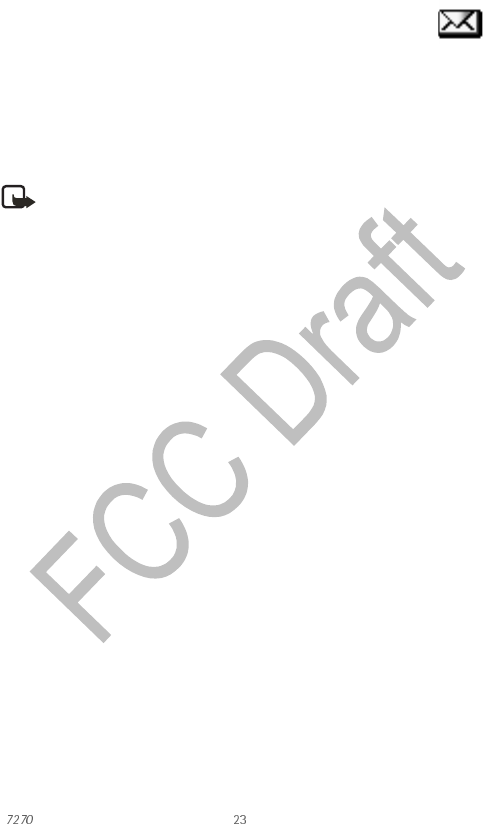
Nokia User Guide Copyright © 2004 Nokia
Messages
5 Messages
If you have subscribed to a message network service, you can send
messages to and receive messages from compatible phones that are also subscribed
to a message service. You can also send and receive picture messages, multimedia
messages, and e-mail if supported by your service provider. To send and receive
messages, you need a messaging service through your service provider, and a
message center number saved in your phone. See “Text entry” on page 21 for more
information.
Note: When sending messages, your device may display Message Sent.
This is an indication that the message has been sent by your device to
the message center number programmed into your device. This is not
an indication that the message has been received at the intended
destination. For more details about messaging services, check with
your service provider.
• Linked messages
Your phone can send and receive long text messages. Long text messages are
automatically split into multiple messages and sent as a series. For this feature
to work properly, the receiving phone must also support linked messages.
While you write a message, the number of available characters and the current
part number of linked message (for example, 120/2) are shown.
While receiving linked messages, you can start reading the first part before the
phone has received the entire message. If you see *some text missing* on the
display, the message content will be updated as soon as the missing sequence
arrives.
If the memory is full, you may have to delete a message from your inbox or
outbox before your phone can update the missing text. See “Delete messages”
on page 26 for more information.
• Font size
Select Menu > Messages > Message settings > Other settings > Font size >
Small font or Large font.

24 Copyright © 2004 Nokia
• Text and picture messages
Settings
1Select Menu > Messages > Message Settings > Text messages >
Sending profile.
2If more than one message profile set is supported by your SIM card, select
the set you want to change; then select one of the following:
Message center number—Save the phone number of the message center,
which is necessary for sending text messages; obtain this number from
your service provider.
Messages sent as—Select the message type Text, E-mail, Page, or Fax.
Message validity—Define how long the network attempts to send your
messages before it gives up.
Default recipient number or E-mail server—For text messages, the default
number used to send messages. For e-mail, the e-mail server number.
Delivery note—Request the network to send delivery notes on your messages.
When a delivery note is received, it goes to the inbox, and displays.
Use GPRS—Set GPRS as the preferred method of sending text messages.
Reply via same center—Allow the recipient of your message to send you a
reply message using your message center (network service).
Rename sending profile—Change the name of the selected profile. This
option is available only if your SIM card supports multiple sending profiles.
It is not available for the default profile.
Folders
You can use folders to organize text and picture messages.
Select Menu > Messages and one of the following folders:
Inbox—Messages are automatically stored in the inbox when they are received.
Outbox—Contains messages you have sent and are waiting to be transmitted.
Sent items—Messages that you have sent are automatically stored in this
folder if Save sent messages is set to On in the message settings for text
messages and multimedia messages.
Saved items—You can store messages that you have read, or that you want to
send later, in this folder.

Nokia User Guide Copyright © 2004 Nokia
Messages
Write and send a message
The indicates the message you composed has not been sent. The
indicates the message you composed has been sent.
1Select Menu > Messages > Create message > Text message, or scroll left
at the start screen.
2Compose a message using the keypad.
3To list available options while composing the message, select Options, and
one of the listed options.
To save the message in the Saved items folder, select Save message >
Saved items or Templates to save the message as a predefined template.
If you have defined any folders under My folders, they also appear in the
list and you can save the message to one of them.
4To send the text message to a single address, select Send; enter the
recipient’s phone number, and select OK; or select Find to retrieve a
number from contacts, and press Select.
5To select other sending options, select Options > Sending options, one of
the options, and follow the prompts.
Read a message
When you receive a text or picture message or SMS e-mail, and a message
alert appears on the display. A message that has been read is indicated by .
The blinking indicates that the message memory is full. Before you can
receive new messages, delete some of your old messages. See “Delete
messages” on page 26 for more information.
1To view the message immediately, select Show.
2To save the message to the inbox for later viewing, select Exit.
3To view a saved message, select Menu > Messages > Inbox.
4If more than one message is received, select the message you want to read.
Unread messages are indicated by .
5While viewing the message, select Options and one of the listed options.
To extract numbers, e-mail addresses, and Web site addresses from the
current message, select Use detail.
To copy text from the message to the phone calendar as a reminder note
for the current day, select Copy to Calendar.
Reply to a message
1While viewing a message, select Reply; then select a Text message.
2Compose your reply and send the message as described in “Write and send

26 Copyright © 2004 Nokia
a message” on page 25.
Forward a message
AS A TEXT MESSAGE
1While viewing a message, select Options > Forward > Via text message.
2Edit the message if desired, and select Send.
3Enter the recipient’s phone number, or retrieve it from contacts, and select
OK.
AS E-MAIL
1While viewing a message, select Options > Forward > Via e-mail.
2Enter the e-mail address, or retrieve it from contacts, and select OK.
3Enter a subject for the e-mail, and select OK.
4Edit the message if desired, and select Send.
5Enter the e-mail server number, and select OK.
Delete messages
If your message memory is full and you have more messages waiting at the
network, blinks in on the start screen. You must read and delete unread
messages, or delete messages from some of your folders.
To delete a single message, select Menu > Messages, the folder, the message
you want to delete, and Options > Delete > Yes.
To delete all messages in a folder, select Menu > Messages > Delete messages,
the folder, and Yes.
• Multimedia messages
A multimedia message is indicated by and can contain text, sound, and a
picture. Your phone supports multimedia messages that are up to 100 KB.
Copyright protections may prevent some images, ringing tones, and other
content from being copied, modified, transferred, or forwarded.
Note: This function can be used only if it is supported by your network
operator or service provider. For availability and a subscription to the
multimedia messaging service, contact your service provider. Only
compatible devices can receive and display multimedia messages.
Multimedia message objects may contain viruses or otherwise be
harmful to your device or PC. Do not open any attachment if you are
not sure of the trustworthiness of the sender.

Nokia User Guide Copyright © 2004 Nokia
Messages
The default setting of the multimedia message service is generally On. The
appearance of a multimedia message may vary depending on the receiving
device.
Multimedia messaging supports the following formats:
• Picture: JPEG, GIF, WBMP, BMP, OTA-BMP, and PNG
• Sound: SP-MIDI, AMR audio, and monophonic ringing tones
• Video: 3GP format (H.263 baseline and MPEG-4 simple profile)
If a received message contains unsupported elements, these elements may be
replaced with the file name.
You cannot receive multimedia messages if you have a call in progress, a game
or other Java application running, or an active browsing session over GSM.
Because delivery of multimedia messages can fail for a variety of reasons, do
not rely solely upon them for essential communications.
MMS settings
AS A CONNECTION SETTINGS MESSAGE
You may be able to receive multimedia connection settings as a connection
settings message from your service provider. For more information, contact
your service provider.
MANUAL ENTRY
Contact your service provider for the settings.
Select Menu > Messages > Message settings > Multimedia msg. >
Configuration settings > Edit active multimedia settings; and each of the
settings in turn, and enter the required information.
OTHER MMS SETTINGS
Select Menu > Messages > Message settings > Multimedia msg. and one of
the following:
Save sent messages—Select Yes to save sent multimedia messages to the Sent
items folder or No to discard.
Delivery notes—Select On for the network to send reports about your messages
(network service).
Scale image down—Select Yes to scale images to a smaller size when inserted
into a message or No to keep the original size.
Default slide timing—Set the default time in mm:ss format for each slide in an
MMS to remain on the screen.

28 Copyright © 2004 Nokia
Allow multimedia reception—Select Yes, No, or In home network for your
multimedia service. In home network cannot receive multimedia messages
outside the home network.
Incoming multimedia messages—Select Retrieve to receive multimedia
messages or Decline to not receive multimedia messages.
Configuration settings—Select Configuration > Default or Personal config.
according to which configuration settings support the multimedia messaging.
See “Configuration settings” on page 58.
Advertisements—Select Yes to enable reception of automatic multimedia
advertisements or No to disable.
Write and send
1Select Menu > Messages > Create message > Multimedia msg., and
enter the text of your message.
2To insert an image, sound or video clip, select Options > Insert and the
type.
3Open the desired Gallery folder, scroll to the file, and select Options >
Insert.
Copyright protections may prevent some images, ringing tones, and other
content from being copied, modified, transferred, or forwarded.
4To add a new page (also called a slide) to the message, select Options >
Insert > Slide.
Each slide can contain text, one image, a calendar note, a business card,
and one sound clip. If the message contains several slides, to open the
desired slide, select Previous slide, Next slide, or Slide list.
5To set other message properties, follow the prompts.
It takes more time to send a multimedia message than to send a text message.
While the multimedia message is being sent, the animated indicator is
displayed, and you can use other functions on the phone. If sending fails, the
message remains in the Outbox folder, and you can try to resend it later. Check
your Outbox folder for unsent messages. Messages that you have sent are
saved in the Sent items folder if the setting Save sent messages is set to Yes.
See “Other MMS settings” on page 27. This is not an indication that the
message has been received at the intended destination.
Read and reply
When a multimedia message is being received, blinks in the display. Once
the message has been fully downloaded, and Multimedia message
received appear in the display.
1To view the message immediately, select Show.

Nokia User Guide Copyright © 2004 Nokia
Messages
2To save the message to the inbox for later viewing, select Exit.
3To view a saved message, select Menu > Messages > Inbox, and scroll to
view the message. Unread messages are indicated by
4While viewing the message, select Play to view the entire MMS, or select
Options and the desired action.
If blinks and Multimedia memory full, view waiting msg. appears in the
display, memory for multimedia messages is full. To view the waiting message,
select Show. Before you can save the message, you need to delete some of your
old messages. See “Delete messages” on page 26 for more information.
•E-mail
You can write, send, and read e-mails with your phone. You can also save and
delete the e-mails on a compatible PC. Your phone supports POP3 and IMAP4
e-mail servers.
Before you can send and receive e-mail messages, you may need to do the
following:
• Obtain a new e-mail account or use your current account. For availability
of an e-mail account contact your e-mail service provider.
• Contact your network operator or e-mail service provider about availability
of this feature and to set the settings required for e-mail. See “Connection
settings service” on page 11 for more information.
• Set the e-mail settings on your phone. See “Settings” on page 29.
Settings
AS A CONNECTION SETTINGS MESSAGE
You may receive the e-mail settings as a connection settings message from the
network operator or service provider. See “Connection settings service” on
page 11.
MANUAL ENTRY
Select Menu > Messages > Message settings > E-mail messages and each of
the following:
Configuration settings > Configuration—Select Default or Personal config.,
depending on which configuration settings support the e-mail application. See
“Configuration settings” on page 58.
Account—Select the e-mail service you want to use.
My name—Enter your name or nickname.
Include signature—Define a signature to be automatically added to the end of
your e-mail messages.

30 Copyright © 2004 Nokia
Reply-to address—Enter the e-mail address to which you want the replies to be
sent.
SMTP password—Enter your password for outgoing e-mails.
Display terminal window—Select Yes to perform manual user authentication
for intranet connections.
Incoming server type—Select POP3 or IMAP4 depending on the type of e-mail
system you are using. If both types are supported, select IMAP4. Changing the
server type also changes the incoming port number.
Incoming mail settings
•Retrieve e-mails—Enter the number of e-mails that you want to retrieve at a
time.
•Retrieval method (shown only if IMAP4, is the selected server type)—
Select Latest if you want to retrieve all newly received e-mails, or
Latest unread if you want to retrieve only e-mails that you have not read.
•IMAP4 password (shown only if IMAP4 is the selected server type)—Enter
the password to access the mailbox. If you have not defined a SMTP user
name or SMTP password, the e-mail server uses the POP3/IMAP4 user
name and password instead.
•POP3 password (shown only if POP3 is the selected server type)—Enter the
password to access the mailbox.
Folders
Your phone has the following folders under Messages > E-mail:
•Inbox—Store received e-mails.
•Other folders—Contains the following subfolders:
Drafts—Store unfinished e-mails.
Archive—Organize and save e-mails.
Outbox—Store e-mails that have not been sent. E-mails are stored in this
folder if you select Send > Send later when sending the e-mail.
Sent items—Store e-mails that have been sent.
Write and send e-mail
You can write your e-mail message before connecting to the e-mail service, or
connect to the service first, and then write and send your e-mail.
1Select Menu > Messages > E-mail > Create e-mail.
2With the E-mail address field highlighted, select Edit.
3Enter the e-mail address; or select Options > Find to retrieve an e-mail
address from contacts, and select OK.

Nokia User Guide Copyright © 2004 Nokia
Messages
4Scroll down to highlight the Subject field, select Edit, enter a subject for
the e-mail, and select OK.
5If desired, select Options > Add new recipient, Add Cc, or Add Bcc.
6Select Options > Message editor and compose your e-mail (total
character count 5000).
7Select Send > Send now or Send later.
If you select Send later, the e-mail is saved in the Outbox folder.
8If you want to edit or continue writing your e-mail later, select Options >
Save draft msg. to save it in the Drafts folder.
9If you have not saved the settings for sending e-mail, enter the number of
the e-mail server at the prompt, and select OK.
Contact your network operator or e-mail service provider for the settings.
Download e-mail messages
If message memory is full, you must delete some of your older messages before
you begin to download messages.
1Select Menu > Messages > E-mail.
2To download e-mail messages that have been sent to your e-mail account,
select Retrieve.
3To download new e-mail messages and send e-mails saved in the Outbox
folder, select Menu > Messages > E-mail > Options > Retrieve and send.
The phone connects to the e-mail service and downloads the messages to
the Inbox folder.
4If multiple messages were received, scroll to the desired message, select
Select to read the new message immediately, or Back to read it later.
Read the message later
Select Menu > Messages > E-mail > Inbox and the message you want to read.
An unread message is indicated by in front of the message.
Reply to an e-mail message
1While viewing a message, select Options > Reply or Reply to all.
2To include the original text in your reply, select Original text; or to reply
without the original text, select Empty screen.
3Confirm or edit the e-mail address, and write your reply.
4Select Options > Send > Send now to send the message.

32 Copyright © 2004 Nokia
Delete e-mail messages
1Select Messages > E-mail > Options > Delete messages.
2To delete all messages from one folder, select the folder, then Yes; to delete
all messages from all folders, select All Messages > Yes.
When you delete an e-mail message from the phone, it is not deleted from the
e-mail server.
• Instant messages (IM)
You can exchange instant messages with compatible phones and other devices
on some service provider networks. This feature requires specific network
configurations. This feature will not access certain independent IM services
such as those hosted by AOL, Yahoo, or MSN.
Select Menu > Messages > Instant messages. From there, you can set up the
IM connection settings, log in to the IM service, and view previous IM
conversations that you have saved.
Contact your service provider for availability and instructions on using this
feature.
• Voice messages
If you subscribe to voice mail, your service provider will furnish you with a voice
mailbox number. You need to save this number to your phone to use voice mail.
When you receive a voice message, your phone lets you know by beeping,
displaying a message, or both. If you receive more than one message, your
phone shows the number of messages received. If supported by the network,
the indicator will show new voice messages.
Save your voice mailbox number
Your service provider may have already saved your voice mailbox number to
your phone. If so, the number will appear in the display in step 2. Select OK to
leave the number unchanged.
1Select Menu > Messages > Voice messages > Voice mailbox number.
2If the Mailbox number box is empty, enter the voice mailbox area code and
number, and select OK.
Call and set up your voice mail
1Once you have saved the voice mailbox number, from the main menu, press
and hold 1.

Nokia User Guide Copyright © 2004 Nokia
Messages
2When you connect to voice mail and the prerecorded greeting begins,
follow the service’s automated instructions to setup your voice mail.
Listen to your voice messages
Once you have set up voice mail, you can dial the number in the following ways:
• Dial the voice mailbox number using the keypad.
• Press and hold 1.
•Select Listen if there is a notification message in the display.
After a brief pause, your phone dials the voice mail number. Once you connect
and the prerecorded greeting begins, follow the automated instructions to
listen to your voice messages.
• Info message service
With the info message network service, you can receive short text messages
from your service provider on various topics, such as weather and traffic
conditions. Contact your service provider for more information.
Select Menu > Messages > Info messages and follow the prompts to configure
you service.
Info service—Select On or Off to activate or deactivate the service, or Topic
index to activate index reception.
Note: If the GPRS connection is set to Always online, info messages
may not be received. In that case, set the GPRS connection to When
needed. See “GPRS, EDGE, CSD, HSCSD” on page 52 for more
information.
• Service commands
Use the Service commands editor to enter and send service requests (also
known as USSD commands) to your service provider. Contact your service
provider for information about specific service commands.
1Select Menu > Messages > Service commands.
2Enter a service request, such as an activation command for a specific
network service, and select Send.

34 Copyright © 2004 Nokia
• Message counter
To view the number of text and multimedia messages you have sent and
received, select Menu > Messages > Message counter > Sent messages or
Received messages.
To clear the counters, select Clear counters.

Nokia User Guide Copyright © 2004 Nokia
Contacts
6 Contacts
Contacts can be saved in the phone memory and on the SIM card.
The phone memory can save up to 500 entries. You can also save
an image with some of the names. The amount of names, numbers and text
entries that you can save varies, depending on their length and the total
number of entries in contacts. Contacts saved on the SIM card are indicated by
.
The phone supports presence-enhanced contacts (network service). In the My
presence menu you can publish your current availability status to show to
anyone who has access to this service and is requesting this information. In the
Subscribed names menu you can create a list of contacts whose presence
status you would like to see.
•Menu
Select Menu > Contacts and one of the following:
Find—Find a name or select from a list.
Add new contact—Add a name to contacts.
Delete—Delete a name and its associated numbers.
My presence—See “Presence service” on page 38.
Subscribed names—See “Subscribed names” on page 41.
Copy—Copy entries from phone memory to SIM and vice versa.
Settings—Set memory in use (phone or SIM), change contacts view, and check
the memory status of your phone and SIM card.
1-touch dialing—Display the list of 1-touch dialing numbers saved to memory.
Voice tags—Display and manage voice tags. See “Voice dialing” on page 44.
Own numbers—View the numbers (line 1, line 2, data) in use by your SIM card.
Caller groups—View and edit the properties (such as the ringing tone) for any
of the caller groups.
• Save information
You can save names and numbers to phone memory or to SIM memory. See
“Select contacts view and memory” on page 46.

36 Copyright © 2004 Nokia
Quickly save a name and number
1At the start screen, enter the phone number you wish to save, and select
Save.
2Enter a name for the number, and select OK.
Save an entry
1Select Menu > Contacts > Add new contact.
2Enter a contact name, and select OK.
3Enter a phone number, and select OK > Done.
Save multiple numbers and text items
For each entry in phone memory, you can save different types of phone numbers
and short text items. The first number you save for any entry is automatically
set as the default, or primary number. It is indicated with a frame around the
number type indicator. If you save multiple numbers, you can designate another
number as the primary number if desired. See “Change the primary number” on
page 37.
1 Select Menu > Contacts > Settings
2Make sure that the memory in use is either Phone or Phone and SIM.
See “Select contacts view and memory” on page 46.
3At the start screen, scroll down; then scroll to the contact entry to which
you want to add a number or text item.
4Select Details > Options > Add number or Add detail and the desired
information category.
5Select an information category, enter the information, and select OK.
6To change the number or text type, with a number or text item highlighted,
select Options > Change type and the desired type.
You cannot change the type of an instant messaging user ID if it is in the
Subscribed names list or in the contact list for group chat.
7Press End to return to the start screen.
Save a user ID for presence service
1At the start screen, scroll down; then scroll to the entry to which you want
to add a user ID.
2With the entry highlighted, select Details > Options > Add detail > User
ID.
3To enter the user ID manually, select Enter ID manually, enter the user ID,
and select OK.

Nokia User Guide Copyright © 2004 Nokia
Contacts
4To search for a user ID in the server of your service provider, select Find.
To search for a user ID, you must be connected to the presence service. See
“Presence service” on page 38.
If one user ID is found it is automatically saved. If multiple user IDs are
found, scroll to the desired user ID, and select Options > Save.
Save addresses and notes
To save an address or note, you need to add it to an existing entry (name).
1At the start screen, scroll down; then scroll to the entry to which you want
to add an address or note.
2With the entry highlighted, select Details > Options > Add detail >
E-mail address, Web address, Street address, or Note.
3Enter the text for the note or address, and select OK.
• Change the primary number
In a contact with more than one phone number, you can select which number
should be the primary number. When you highlight the contact and press Call,
the phone automatically dials the primary number.
1At the start screen, scroll down; then scroll to the entry you want to
change, and select Details.
2Scroll to the number you want to set as default, and select Options > Set
as default.
• Search for an entry
1At the start screen, scroll down to display the contents of Contacts.
2Press the key that corresponds to the first letter of the name for which you
are searching.
3Select Details to view the details of the selected entry.
4Scroll up and down through the details of the entry, if necessary.
• Make a call
At the start screen, scroll down; then scroll to the entry for the person you want to
call.
To dial the primary number, press Call.

38 Copyright © 2004 Nokia
To dial one of the other numbers for that contact, select Details, scroll to the
desired number, and press Call.
• Add an image to a name or number
You can add an image to a name or number saved in phone memory. That image
is displayed when you receive a call from that phone number.
1At the start screen, scroll down.
2Scroll to the name or number, and select Details > Options > Add image.
The display shows the list of folders in the Gallery.
3Scroll to the folder that contains the image, and select Open.
4Scroll to the desired image, and select Options > Save to contacts.
A copy of the image is added to the contact.
You can use the phone to take a photo and attach it to the contact. See “Take
a photo” on page 64 for more information.
• Edit an entry
1At the start screen, scroll down; then scroll to the entry that you want to
edit, and select Details.
2Scroll to the item you want to edit, and select Options.
The list of available options varies according to the type of item selected.
3Select an option, and follow the prompts to edit the item.
• Delete names and numbers
1Select Menu > Contacts > Delete.
2To delete individual names and numbers, select One by one.
3Scroll to the entry you wish to delete, and select Delete > Yes to confirm
the deletion.
4To delete the entire contents of contacts, select Delete all > Phone or SIM
card > Delete > Yes.
5At the prompt, enter your security code, and select OK.
• Presence service
Presence service is a network service that lets you give information about your
presence status to other people who have access to the same presence service.
These others are know as viewers. Your presence status includes your

Nokia User Guide Copyright © 2004 Nokia
Contacts
availability, status message, and personal logo. When you publish your current
presence status, viewers can request this information by using their Subscribed
names list. See “Subscribed names” on page 41.
You can control and personalize the information that you want to share with
viewers. You can decide who can view all of your presence information, who
can view only your availability, and who cannot view your presence at all. For
example, you may want to display a message to the viewers in your private list
telling them that you are in a business meeting until 5:00 p.m., but you may
want your other viewers to simply see that you are not available.
Before you can use presence, you must subscribe to the service. To check the
availability of the presence service, contact your service provider. The service
provider will supply your user ID and password and the settings for the service.
To set the required settings, see “Configuration settings” on page 58.
You need to access the presence service before you can share your presence
information with others. Viewers need access to the presence service and a
compatible phone to see your presence information.
Connect and disconnect
While you are connected to the presence service, you can use the other
functions of the phone, and the presence service remains active in the
background.
Select Menu > Contacts > My presence > Connect to “My presence” service.
To disconnect from presence service, select Menu > Contacts > My presence >
Disconnect.
Change your presence status
Select Menu > Contacts > My presence > My current presence and one of
the following:
View current presence—Select Private pres. or Public pres. to view your
current private or public status.
My availability—Set your availability status. Select Available (indicated by ),
Busy (indicated by ), or Not available (indicated by ). Setting an
availability status does not prevent your phone from receiving calls or messages
or change the behavior of the phone in any way.
My presence message—Enter a status message to be shown to other persons,
or select Options > Previous msgs. and an old message as the status message.
You can use the message to tell viewers where you are, what you are doing, or
any other information that you wish to share.
My presence logo—Select your personal logo from the Graphics folder in the
gallery. If you select Default, the logo is not published.

40 Copyright © 2004 Nokia
Show to—Choose the groups with whom you want to share or not share your
presence status information. Select one of the following:
•Private and public—Contacts in your private list can see your full presence
information; other contacts can see only your availability.
•Private viewers—Contacts in your private list can see your full presence
information; other contacts cannot see any information.
•No one—No one can see your presence information.
Manage viewers
VIEW LISTS OF VIEWERS
Select Menu > Contacts > My presence > Viewers and one of the following:
Current viewers—View all the persons who have subscribed to your presence
information.
Private list—View the list of persons who are allowed to see all of your presence
information. Viewers who are not in your private list can see only your
availability.
Blocked list—View the list of persons you have blocked from viewing your
presence information.
ADD AND REMOVE VIEWERS
Viewers on your private list can see all of your presence information, including
availability, status message, and logo.
1Select Menu > Contacts > My presence > Viewers > Current viewers >
Options > Add to private list.
2Scroll to each viewer that you want to add to your private list, and select
Mark.
3To remove a viewer from the private list, select Unmark.
4When you are finished, select Done.
BLOCK AND UNBLOCK VIEWERS
Viewers on your blocked list cannot see any of your presence information.
1Select Menu > Contacts > My presence > Viewers > Current viewers >
Options > Move to blocked list.
2Scroll to each viewer that you want to add to your blocked list, and select
Mark.
3To remove a viewer from the blocked list, select Unmark.
4When you are finished, select Done.

Nokia User Guide Copyright © 2004 Nokia
Contacts
Settings
Select Menu > Contacts > My presence > Settings and one of the following:
Show current presence in idle—Choose whether to show your current presence
status on the start screen. Select On to show the current status indicator or Off
to hide it.
IM and my presence settings—Lets you modify your presence settings.
Synchronize with profiles—You can update your presence message and
availability status automatically by linking them to the currently active profile.
See “Customize a profile” on page 48. Select On to update automatically or Off
to update manually. You cannot link a personalized status logo to a profile.
Connection type—Select Automatic to have the phone connect automatically
to the presence service when the phone is switched on. Select Manual connect
to the presence service manually.
Connect. settings—Select from the following:
•Configuration— Select Default or Personal config. according to which
configuration settings support presence service. See “Configuration
settings” on page 58.
•Account—Select a presence account contained in the active configuration.
•User ID—Enter the user ID you received from your service provider.
•Password—Enter the password you received from your service provider.
• Subscribed names
You can create a list of contacts whose presence status information you want
to know. You can view the information if the contacts allow you to view it and
the network does not prevent it. You can view these subscribed names either
by scrolling through your contact list or by using the Subscribed names
submenu.
Connect to service
1Make sure that the memory in use is either Phone or Phone and SIM.
See “Select contacts view and memory” on page 46.
2To connect to the presence service, Select Menu > Contacts > My
presence > Connect to My presence service.
When you are not connected to the presence service, you can view the
subscribed names but you cannot see their presence status information.

42 Copyright © 2004 Nokia
Subscribe to a contact
FROM THE SUBSCRIBED NAMES MENU
1Select Menu > Contacts > Subscribed names.
If you have not connected to the presence service, the phone asks if you
want to connect now.
2If your list of contacts is empty, select Add.
3If your list of contacts is not empty, select Options > Subscribe new, and
select a contact from the list.
If the contact has a user ID saved, the contact is added to the subscribed
names list. If there are multiple user IDs, select one of them. After
subscription to the contact, Subscription activated is shown.
FROM THE CONTACT LIST
1At the start screen, scroll down; then scroll to the contact you want to
subscribe to.
2Select Details > Options > Request presence.
3To subscribe to the contact, select As subscription.
4To view the contact’s presence information without subscribing, select
One time only.
View subscribed names
1Select Menu > Contacts > Subscribed names.
The status information of the first contact on the dynamic contacts list is
displayed. The information that the person wants to give to the others may
include text and some of the following icons:
, , or indicate that the contact is either available, busy, or not
available.
indicates that the contact presence information is not available.
2Scroll to the desired contact, and select one of the following:
Details—View the details of the selected contact.
Options—Select an option from the list.
Unsubscribe a contact
FROM THE SUBSCRIBED NAMES MENU
1Select Menu > Contacts > Subscribed names.
2Scroll to the contact that you want to unsubscribe, and select Options >
Unsubscribe.

Nokia User Guide Copyright © 2004 Nokia
Contacts
FROM THE CONTACT LIST
1At the start screen, scroll down; then scroll to the contact you want to
unsubscribe.
2Select Details, the ID, and Options > Unsubscribe > OK.
• Copy entries
Text entries such as e-mail addresses saved in the phone memory are not copied
to the SIM card.
1Select Menu > Contacts > Copy > From phone to SIM card or
From SIM card to phone and one of the following:
One by one—Selects and copies entries one by one. Go to step 2.
All—Copies all entries from the SIM card or phone. Go to step 3.
Primary numbers—Copies only primary numbers. This appears only if you
selected From phone to SIM card. Go to step 3.
2Scroll to the entry you wish to copy, and select Copy > Keep original or
Move original.
Select Keep original if you are unsure of which copy method to use. This
ensures original entries are merely copied to the new location. Move
original deletes files at their former location after copying.
The entry is copied and you are returned to the list of contact entries.
3If you selected All or Primary numbers in step 1, select Keep original or
Move original > Yes to confirm your choice.
All entries are copied to the selected destination.
4Press End to return to the start screen.
• Business cards
You can send and receive an entry in Contacts to a compatible phone or other
handheld device using IR or a text or multimedia message, if supported by your
service provider.
Receive a business card using IR
1Select Menu > Settings > Connectivity > Infrared to ensure IR is activated.
When you receive the business card, your phone beeps, and a message
appears in the display.
2Select Show > Save to save the business card in phone memory or Exit >
OK to discard the business card.

44 Copyright © 2004 Nokia
Send a business card
1Highlight an entry from Contacts that you wish to send, and select
Details > Options > Send bus. card > Via infrared, Via text message, or
Via multimedia.
2Follow the prompts to finish sending the business card.
•1-touch dialing
You can assign any phone number to any key from 2–9, and dial the number by
pressing and holding the assigned key. If you assign a number that is not
already in your contact list, the number is added to the list.
Assign a key
1Select Menu > Contacts > 1-touch dialing.
2Scroll to any empty slot, and select Assign.
3Enter the number (including the area code), select OK, enter a name for
the number, and select OK.
Make a call
Press and hold the key to which an entry has been assigned. Your phone dials
the entry assigned to the key.
Change numbers
1Select Menu > Contacts > 1-touch dialing.
2Scroll to the 1-touch dialing entry you wish to change, and select
Options > Change.
3Enter the number (including the area code), select OK, enter a name for the
number, and select OK.
Delete numbers
1Select Menu > Contacts > 1-touch dialing.
2Scroll to the 1-touch dialing location you wish to delete, and select
Options > Delete > Yes.
• Voice dialing
You can make a phone call by saying a voice tag that has been added to a phone
number in contacts. Any spoken word, such as a name, can be a voice tag.
Before using voice tags, note that:

Nokia User Guide Copyright © 2004 Nokia
Contacts
• Voice tags are not language-dependent. They are dependent on the speaker's
voice.
• You must say the name exactly as you said it when you recorded it.
• Voice tags are sensitive to background noise. Record them and make calls
in a quiet environment.
• Very short names are not accepted. Use longer, unique names (for example,
“John Smith, work”)
• When recording a voice tag or making a call using a voice tag, hold the
phone in the normal position at your ear.
Note: Using voice tags may be difficult in a noisy environment or during
an emergency, so you should not rely solely upon voice dialing in all
circumstances.
Assign a voice tag
1At the start screen, scroll down to display the entry you would like to
assign a voice tag, and select Details.
2If the entry has multiple numbers, scroll to the number you wish to tag.
3Select Options > Add voice tag > Start.
4After the phone beeps, pronounce the voice tag clearly into the
microphone.
After the voice tag is recorded, it is replayed through the earpiece, and a
confirmation note appears in the display. The icon is displayed next to
the number in the contact list.
Voice dial a number
1At the start screen, press and hold the Volume down key or the Right
selection key; or if you are using a compatible headset with a headset key,
press and hold the headset key.
The phone beeps, and Speak now appears in the display.
2Within 3 seconds, speak the tag into the microphone.
Once the voice tag is recognized, the tagged entry appears in the display,
replays through the earpiece, and the number is dialed.
Display, change, and delete voice tagged entries
1Select Menu > Contacts > Voice tags.
2Scroll to view the voice tags, select a voice tag, and Playback, Change, or
Delete.

46 Copyright © 2004 Nokia
• Caller groups
You can add contacts entries to any of five caller groups and assign a unique ringing
tone or graphic to that group. This enables you to identify callers from the group by
their unique ringing tone or graphic. A caller group can be as small as one person
or as large as the contacts list. You can rename caller groups to suit your preference.
To set the phone to ring only for calls from members of a selected caller group,
see the Alert for option in “Customize a profile” on page 48.
Set caller group options
1Select Menu > Contacts > Caller groups > Family, VIP, Friends, Business,
or Other > Rename group, Group ringing tone, Group logo, or Group
members.
2 Follow the prompts to set the option according to your preference.
Add a name to a caller group
1Recall a name from contacts, and select Details > Options > Caller groups.
2Select the caller group to which you want to add the name.
Remove a name from a caller group
1Select Menu > Contacts > Caller groups > Family, VIP, Friends, Business,
or Other > Group members.
2Scroll to the name you want to remove, and select Options > Remove
contact.
• Select contacts view and memory
At the start screen, select Contacts > Settings and one of the following:
Memory in use—Select the memory you wish to use. Options are Phone, SIM
card, or Phone and SIM combined. With Phone and SIM selected, when you
save a new contact entry, it is saved to phone memory only. However, when you
display the contact list you can see the entries in both phone memory and the
SIM card.
Contacts view—Select the Name list, Name and number, Name only, or Name
and image.
Memory status—View the amount of phone or SIM memory used and available.

Nokia User Guide Copyright © 2004 Nokia
Call log
7 Call log
Call log stores information about the last 20 missed, 20 received, and
20 dialed calls. It also adds the total duration of all calls. When the number of
calls exceeds the maximum, the most recent call replaces the oldest. For Call
log to work properly:
• Your service provider must support caller ID, and it must be enabled.
• Your calls cannot be blocked.
• Your phone must be on and within the service area.
• Missed, received, and dialed calls
1Select Menu > Call log > Missed calls, Received calls, or Dialed numbers.
2Scroll to a name or number of interest, select Options, and one of the listed
options.
• Positioning
The network may deliver location information of your phone if you approve it
(network service). Contact your network operator or service provider to
subscribe and to agree upon the delivery of location information.
The network may send you a location request.
To accept or reject the location request, select Accept or Reject. If you miss the
request, the phone automatically accepts or rejects it according to what you
have agreed with your network operator or service provider. The phone displays
1 missed position request. To view the missed location request, select Show.
To view the information on the 10 most recent position requests, or to delete them,
select Menu > Call log > Positioning > Positioning log > Open folder or
Delete all.

48 Copyright © 2004 Nokia
8 Settings
Use this menu to set or change your personal shortcuts, time and
date settings, call settings, phone settings, display settings, tone
settings, enhancement settings, security settings, and to restore factory
settings.
• Profiles
Profiles define how your phone reacts when you receive a call or a message,
how your keypad sounds when you press a key, and more. Ringing options,
keypad tones, and other settings can be left at their default setting, or
customized to suit your needs. Select and customize the most suitable profile
for your situation, such as when you are in a meeting or outdoors. The profiles
available are Normal, Silent, Meeting, Outdoor, and Pager.
Profiles are also available for enhancements such as a headset and car kit. See
“Enhancement settings” on page 58 for more information about enhancement
profiles.
Select a profile
Select Menu > Settings > Profiles, a profile from the list, and Activate; or in
the start screen, briefly press the Power key, scroll to the desired profile, and
press and hold the Power key.
Customize a profile
You can customize any of the profiles a variety of ways.
1Select Menu > Settings > Profiles.
2Select the profile you want to customize; select Customize and one of the
listed options.
For Alert for, define which caller groups the selected profile will accept or
decline. See “Caller groups” on page 46 for more information.
For My presence, set your availability status and presence message for the
selected profile. This option appears only if the Synchronize with profiles
presence setting is set to On. See “Presence service” on page 38 for more
information.

Nokia User Guide Copyright © 2004 Nokia
Settings
Set a timed profile
Timed profiles can be used to prevent missed calls. For example, suppose you
attend an event that requires your phone be set to Silent before the event
starts, but you forget to return it to Normal until long after the event. During
this time, you have missed several calls because the ringing tone was silent.
With the timed profile feature, you can set a profile to expire after any length of
time up to 24 hours. When the profile expires, your phone automatically returns
to the default profile.
1Select Menu > Settings > Profiles, a profile, and Timed.
2Enter the time for the profile to expire, and select OK.
The profile you have set for expiration is now active and appears in the
start screen along with a small clock icon.
Change presence status
This function is available if you have set Synchronize with profiles to On. See
“Presence service” on page 38.
1Select Menu > Settings > Profiles, and a profile.
2Select Customize > My presence and one of the following:
My availability—Select your status (Available, Busy, or Not available).
My presence message—Edit your status message, and select OK.
•Themes
A theme contains many elements for personalizing your phone, such as
wallpaper, screen saver, color scheme, and a ringing tone.
Select Menu > Settings > Themes and follow the prompts.
• Tone settings
You can adjust the ringing volume, keypad tones, and more for the active
profile.
Select Settings > Tone settings.
The options are the same as those in “Customize a profile” on page 48, except
that My presence and Profile name are not available.

50 Copyright © 2004 Nokia
• Main display settings
Select Menu > Settings > Main display settings, and one of the listed options.
• Mini display settings
Images on the mini display may not be as bright as those on the main display.
Select Menu > Settings > Mini display settings, and one of the listed options.
• Time and date settings
Set the clock
1Select Menu > Settings > Time and date settings > Clock > Set the time.
2Enter the time in hh:mm format, and select OK.
3If required, select am or pm.
Show or hide the clock
Select Menu > Settings > Time and date settings > Clock > Hide clock or
Show clock.
Change the time format
You can set the time format for am/pm or 24-hour format (military time).
Select Menu > Settings > Time and date settings > Clock > Time format >
24-hour or 12-hour.
Set the date
1Select Menu > Settings > Time and date settings > Date > Set the date.
2Enter the date, and select OK.
Show or hide the date
Select Menu > Settings > Time and date settings > Date > Show date or
Hide date.
Set or change the date format
1Select Menu > Settings > Time and date settings > Date > Date
separator and the separator of your choice (period, slash, hyphen, or
space).
2Select Date > Date format and the format of your choice.

Nokia User Guide Copyright © 2004 Nokia
Settings
Automatic update of date and time
This is a network service. You can set the phone to update the date and time
from the network when you turn the phone on. Automatic update of the date
and time does not change the time you have set for the alarm clock, calendar,
or alarm notes. They are in local time. Updating may cause some alarms that
you have set to expire.
Select Menu > Settings > Time and date settings > Auto-update of
date & time and one of the following:
On—Update the time automatically
Confirm first—Request confirmation before updating the time. You can accept
or decline the update.
Off—Do not automatically update the time.
• Personal shortcuts
Right selection key
You can set the Right selection key to go directly to a specific function from
the start screen.
Select Menu > Settings > Personal shortcuts > Right selection key and one
of the functions in the list.
The selected name or function appears over the Right selection key in the start
screen.
Voice commands
Some phone functions can be voice-activated.
1Select Menu > Settings > Personal shortcuts > Voice commands, the
desired feature, Select, the function, and select Add.
2Select Start and speak after the tone.
See “Voice dialing” on page 44.
You cannot activate or add a voice command during a call or while sending or
receiving data over a GPRS connection.
• Connectivity
You can connect the phone to a compatible device or PC using an IR connection
or a data cable. You can also use the phone as a wireless modem to enable GPRS
mobile link from a compatible PC.

52 Copyright © 2004 Nokia
For information on using a data communication application, refer to the
documentation provided with the application.
For more information on Nokia PC Suite applications, see the Nokia PC Suite online
help. Nokia PC Suite and all related software can be downloaded from
www.nokia.com/us.
Infrared
You can send or receive data such as business cards, graphics, images, sound
clips, videos, and calendar notes to or from a compatible phone or data device
(such as a computer) using the IR port of your phone.
For better performance during an IR connection, place the phone on a
stationary surface. Do not move the phone while the IR connection is active.
The preferable distance between the two devices in an IR connection is from 3
inches to 3 feet.
Do not point the IR beam at anyone’s eye or allow it to interfere with other IR
devices. This device is a Class 1 laser product.
SEND AND RECEIVE DATA
1Ensure that the IR ports of the sending and receiving devices are pointing
at each other and that there are no obstructions between the devices.
2To activate IR in your phone, select Menu > Settings > Connectivity >
Infrared from the menus.
3The user of the other device should activate IR as well.
If data transfer is not started within 2 minutes after the activation of the IR
port, the connection is canceled and must be restarted.
CONNECTION INDICATOR
• When is shown continuously, the IR connection is activated and your
phone is ready to send or receive data using its IR port.
• When blinks, your phone is trying to connect to the other device or a
connection has been lost.
GPRS, EDGE, CSD, HSCSD
With your phone you can use general packet radio service (GPRS), high-speed
circuit switched data (HSCSD), and circuit switched data (CSD). The use of
HSCSD services consumes the battery faster than normal voice or data calls.
You may need to connect the phone to a charger during HSCSD data transfer.

Nokia User Guide Copyright © 2004 Nokia
Settings
With GPRS, you can stay connected to the mobile Internet and allow faster
downloads without completing a dial-up connection. Applications using GPRS
include MMS, SMS messaging, browsing sessions, e-mail, remote
synchronization, and the PC dial-up. Your phone can support three
simultaneous GPRS connections.
Enhanced GPRS (EGPRS, or EDGE) is similar to GPRS but the connection is
faster.
To use the EDGE service, subscribe to it from your service provider, and save the
GPRS settings for the functions that you want to use over the EDGE network. For
information on pricing, availability, and data transfer speed, contact your service
provider.
When you have selected GPRS as a data bearer, the phone uses EDGE instead
of GPRS if this is available in the network. You cannot choose between EDGE
and GPRS, but for some applications, such as browsing mobile Internet pages,
you may be able to select either GPRS or CSD.
The phone can support three simultaneous GPRS connections.
DEFINE GPRS CONNECTION
Depending on your service, you may be able to define when the phone connects
to the GPRS or EDGE network.
Select Menu > Settings > Connectivity > GPRS > GPRS Connection and one
of the following:
When needed—The phone registers and connects to the GPRS or EDGE network
only if you use a function that needs the GPRS service. The connection closes
when you exit the application. Establishing a connection may take longer than
when Always online is selected.
Always online—The phone automatically registers to a GPRS or EDGE network
when you switch the phone on, if the network is available in your location.
When you start an application using GPRS, the connection between the phone
and the network is established. When you exit the application, the connection
ends, but the phone is still registered to the network.
GPRS MODEM SETTINGS
When you use your Nokia phone as a wireless modem, you can enable a GPRS
mobile link from your PC or laptop computer.
Before you can use GPRS technology, you must save the GPRS settings for each
of the applications used over GPRS. Some service providers may have already
set up information for your GPRS dial-up connection.
In order to use GPRS, you must first subscribe to the network service. Contact
your service provider for details.

54 Copyright © 2004 Nokia
1Select Menu > Settings > Connectivity > GPRS > GPRS modem
settings > Active access point and the access point that you want to
activate.
2Select Edit active access point to change the access point settings.
Contact your service provider for the access point name.
You can also set the GPRS dial-up service settings (access point name) on your
PC using the Nokia Modem Options software. See the Nokia PC Suite online
help for more information. If you set the settings on both the phone and the
PC, the PC settings will be used.
GPRS ICONS
The following icons appear in the upper left corner of the screen to show you
the status of your GPRS connection.
Data cable
To use the DKU-2 data cable:
1Connect the cable to the USB port on your computer and to the Pop-Port™
connector on your phone.
2Start using the data communications application on the computer.
Making or answering phone calls during a computer connection is not
recommended as it might disrupt the operation.
• Call settings
Call forwarding
Call forwarding tells your network to redirect incoming calls to another
number.
Call forwarding is a network service and may not work the same in all networks.
Contact your service provider for more information.
ACTIVATE CALL FORWARDING
1Select Menu > Settings > Call settings > Call forwarding and one of the
following:
Forward all voice calls—Forward all calls to the number you specify.
Indicates an active GPRS connection (for example, when you are using
the browser).
Indicates that the GPRS connection has been interrupted by a voice call
or text message.

Nokia User Guide Copyright © 2004 Nokia
Settings
Forward if busy—Forward all calls when you are in a call.
Forward if not answered—Forward all calls to another number if you do
not answer. You can also set a delay before forwarding takes place.
Forward if out of reach—Forward all calls when your phone is turned off
or out of the coverage area.
Forward if not available—Forward all calls when you do not answer, your
phone is busy or turned off, or out of the coverage area. You can also set
a delay before forwarding takes place.
Forward all data calls—Forward all data calls to a data mailbox.
Cancel all call forwarding—Cancel any call forwarding options you have
set.
2Select Activate; then select the destination to which your calls will be
forwarded.
3Enter the number to which your calls, data, or other information will be
forwarded, and select OK; or select Find to retrieve a number from
contacts.
4If required, select the delay time before the call is forwarded.
Your phone calls the network to activate the feature you have requested. The
network sends a confirmation note when the feature has been activated
successfully.
CANCEL CALL FORWARDING
1Select Menu > Settings > Call settings > Call forwarding.
2Select Cancel all call forwarding; or one of the call forwarding options,
and select Cancel.
Canceling all call forwarding may affect your ability to receive voice mail
messages. Contact your service provider for specific details.
Anykey answer
Anykey answer allows you to answer an incoming call by briefly pressing any
key except the Power key, the selection keys, and the End key.
Select Menu > Settings > Call settings > Anykey answer > On or Off.
Answer when fold is open
You can determine whether opening the fold automatically answers an incoming
call.
Select Menu > Settings > Call settings > Answer when fold is open > On or
Off.

56 Copyright © 2004 Nokia
Automatic redial
Occasionally, your network may experience heavy traffic, resulting in a fast
busy signal when you dial. With automatic redial activated, your phone redials
the number up to 10 times, and notifies you once the network is available.
Select Menu > Settings > Call settings > Automatic redial > On or Off.
1-touch dialing
You can turn the 1-touch dialing feature on and off. For more information, see
“1-touch dialing” on page 44.
Select Menu > Settings > Call settings > 1-touch dialing > On or Off.
Call waiting
If supported by your service provider, call waiting notifies you of an incoming
call even while you are in a call. You can accept, reject, or ignore the incoming
call.
ACTIVATE OR DEACTIVATE
Select Menu > Settings > Call settings > Call waiting > Activate or Cancel.
CHECK STATUS
You can see whether call waiting is active, and for which type of calls.
Select Menu > Settings > Call settings > Call waiting > Check status.
USE CALL WAITING
1During a call, press Call to answer the waiting call.
The first call is put on hold.
2Press End to end the active call.
Summary after call
You can display the time spent on a call when you hang up (network service).
Select Menu > Settings > Call settings > Summary after call > On or Off.
Send my caller identity
You can prevent your number from being displayed on the receiving party’s
caller ID. This feature is a network service and works on a call-by-call basis.
Contact your service provider for more information.
Select Menu > Settings > Call settings > Send my caller ID > Set by network,
Yes, or No.

Nokia User Guide Copyright © 2004 Nokia
Settings
• Phone settings
Language
To set the language for the display texts, select Menu > Settings > Phone
settings > Language settings. If you select Automatic, the phone selects the
language according to the data in the SIM card.
Phone memory
You can check the amount of memory available in the phone. For more
information, see “Shared memory” on page 3.
Select Menu > Settings > Phone settings > Memory status, and scroll
through the list to view the memory associated with each item.
Security keyguard
You can set the phone to ask for the security code when you unlock the
keyguard.
1Select Menu > Settings > Phone settings > Security keyguard.
2Enter the security code, and select OK > On or Off.
Welcome note
You can write a welcome note which shows up briefly on your display whenever
you power up your phone. You must use standard text input for entering
welcome note text. Press * to display and select from available special
characters and smileys.
1Select Menu > Settings > Phone settings > Welcome note.
2Enter a note (up to 44 characters), and select Save.
System selection
You may be able to manually search for another network which has a roaming
agreement with your home service provider.
Select Menu > Settings > Phone settings > Operator selection and one of the
following:
Automatic—Your phone defaults to those settings which have been preset by
your service provider.
Manual—Your phone searches for a network which has a roaming agreement
with your service provider.
If No system access appears in the display, you need to switch to Automatic
mode, or insert another SIM card into the phone.

58 Copyright © 2004 Nokia
Confirm SIM service actions
This option allows you to request notification when your service provider makes
changes to SIM-related services (such as activating GPRS service).
Select Menu > Settings > Phone settings > Confirm SIM service actions >
Yes or No.
Help text
For information about help text, see “In-phone help” on page 6.
• Enhancement settings
The Enhancement settings menu is shown only if the phone is or has been
connected to one of the compatible enhancements such as the headset. Each
compatible enhancement appears in the Enhancement settings menu only
after it has been connected to the phone.
Select Menu > Settings > Enhancement settings and one of the available
enhancements; then select the option of your choice and follow the prompts.
• Configuration settings
You can configure your phone with settings that are required for certain
services to function correctly. The supported services are multimedia
messaging, instant messaging, synchronization, e-mail application, streaming,
and browser. Your service provider may also send you these settings. See
“Connection settings service” on page 11.
For information on availability and the appropriate configuration settings,
contact your network operator or service provider.
Select Menu > Settings > Configuration settings and one of the following:
Default configuration sett.—Scroll to a service provider, and select Details to
view the services that the configuration settings of this service provider
supports, or select Options and one of the following:
•Set as default—Set the configuration settings of the service provider as
default settings.
•Delete—Delete the configuration settings.
Activate default in all applications—Activate the default configuration
settings in all services.
Preferred access point—Scroll to an access point, and select Options > Details
to view the name of the service provider, data bearer, and GPRS access point or
GSM dial-up number.

Nokia User Guide Copyright © 2004 Nokia
Settings
Personal config. settings—Add new personal accounts for various services, and
activate or delete them. To add new configuration settings if you have not
added any, select Add new; otherwise, select Options > Add new. Select the
service type, and one by one select and key in all the required parameters. The
parameters differ according to the selected service type. To delete or activate a
personal account, scroll to it, and select Options > Delete or Activate.
• Security settings
Security features help to prevent accidental calls, allow you to restrict the calls
your phone can make and receive, and keep your stored information safe.
PIN code request
The PIN code (4–8 digits) provides extra security in case your phone is lost or
stolen. The PIN code must be obtained from your service provider. It is typically
provided with your SIM card.
You can set your phone to request the PIN code upon power-up. After three
successive incorrect entries the PIN code is blocked and you are asked to enter
the personal unblocking key (PUK) code. Some SIM cards do not allow you to
turn the PIN code request off.
1Select Menu > Settings > Security settings > PIN code request.
2At the prompt, enter the PIN code, and select OK.
3Scroll to On, and select OK.
Call restrictions
This network service lets you restrict the calls your phone can make and receive.
Check with your service provider for details.
When calls are restricted, calls may be possible to emergency numbers
programmed into your phone (for example, 911). Enter the emergency number
and press Call. The number appears in the display after you have keyed in the
last digit.
TURN ON CALL RESTRICTIONS
1Select Menu > Settings > Security settings > Call restrictions and one of
the following:
Outgoing calls—Calls cannot be made.
International calls—Calls cannot be made to foreign countries.
Int. calls except to home country—When abroad, calls can be made only
within the current country and to your home country (that is, the country
where your home network operator is located).

60 Copyright © 2004 Nokia
Incoming calls—Calls cannot be received.
Incoming calls if roaming—Calls cannot be received outside your home
area.
Cancel all call restrictions—Turns off all call restrictions. Calls can be
made and received in the usual way. If you select this option, steps 2 and
3 are not available.
2Scroll to one of the following options:
Activate—Enter the restriction password, and select OK.
Cancel—Enter the restriction password, and select OK. This option allows
you to cancel one type of call restriction and leave others in force.
Check status—The phone lists the call types with call restriction active.
3Select OK.
CHANGE YOUR RESTRICTION PASSWORD
Contact your service provider for your original restriction password.
1From the menus, select Settings > Security settings > Access codes >
Change restriction password.
2Enter your current password, and select OK.
3Enter your new password, and select OK.
4Re-enter your new password for verification, and select OK.
Fixed dialing
Once you set up and activate a fixed dialing list, your phone can make calls only
to those numbers that you have defined in the fixed dialing list. Fixed dialing is
a network feature and must be supported by your service provider.
If you activate fixed dialing and the number list is empty, all outgoing calls,
except for emergency numbers such as 911, require entry of the PIN2 code.
When fixed dialing is on, calls may be possible to emergency numbers
programmed into your phone (for example, 911). Enter the emergency number and
press Call. The number appears in the display after you have keyed in the last digit.
SET UP AND ACTIVATE A FIXED DIALING LIST
1Select Menu > Settings > Security Settings > Fixed dialing > Number
list.
Fixed dialing not active appears in the display followed by
Fixed dialing list empty.
2At the prompt, enter the PIN2 code, and select OK.
3Enter the fixed dialing number, or select Find to retrieve a number from
contacts, and select OK.

Nokia User Guide Copyright © 2004 Nokia
Settings
4Enter a name for the number, and select OK.
5Select Back > On to activate fixed dialing.
VIEW OR EDIT THE FIXED DIALING LIST
1Select Menu > Settings > Security Settings > Fixed dialing > Number
list.
2At the prompt, enter the PIN2 code, and select OK.
3Scroll to a number, and select Options, and an option from the list.
NOTES ABOUT FIXED DIALING
• If a SIM card with fixed dialing that is activated is inserted into a phone
that does not support fixed dialing, the SIM card is rejected.
• When fixed dialing is on, GPRS connections are not possible except while
sending text messages over a GPRS connection. In this case, the recipient’s
phone number and the message center number must be included in the
fixed dialing list.
• You cannot access SIM memory manually (view or copy numbers on the
SIM card) while fixed dialing is active.
Closed user groups
A closed user group is a network service that specifies the group of people whom
you can call and who can call you. For more information, contact your service
provider.
1Select Menu > Settings > Security settings > Closed user group > On,
Off, or Default.
2If you selected On, enter the group number provided by your service
provider, and select OK.
When calls are limited to closed user groups, calls may be possible to
emergency numbers programmed into your phone (for example, 911). Enter the
emergency number and press Call. The number appears in the display after you
have keyed in the last digit.
Security levels
The security level determines your access to features when a non-owner SIM card
is used. A non-owner SIM card is one (other than the original) that is inserted
after you power off the phone. There are three security levels:
Off—Owner and non-owner cards are treated the same.
Memory—The phone will ask for the security code when the SIM card memory
is selected and you want to change the memory in use or copy from one
memory to another.

62 Copyright © 2004 Nokia
Phone—The security code is required whenever a new SIM card is inserted.
Use the following to set your security level.
1Select Menu > Settings > Security settings > Security level.
2At the prompt, enter the security code (default 12345), and select OK >
Off, Memory, or Phone.
Access codes
SECURITY CODE
The security code (5–10 digits) controls access to features such as the security
level and is supplied with the phone. The preset code is 12345.
If you enter the wrong security code five times in succession, you will not be able
to enter a code for five minutes, even if you power off the phone between
incorrect entries.
Once you change the security code from its preset of 12345, keep the new code
secret and in a safe place separate from your phone. Use this procedure to change
your security code.
1Select Menu > Settings > Security settings > Access codes > Change
security code.
2At the prompt, enter the current security code (default 12345), and follow
the prompts.
PIN CODE
Before you can change your PIN code (4–8 digits), you need to enable PIN code
request. See “PIN code request” on page 59.
1Select Menu > Settings > Security settings > Access codes >
Change PIN code.
2At the prompt, enter the current PIN code, and follow the prompts.
PIN2 CODE
The PIN2 code (4–8 digits) is required for features such as fixed dialing. If you
enter an incorrect PIN2 code three times in succession, the PIN2 code is blocked
and you will have to enter the PUK2 code.
The original PIN2 code must be obtained from your service provider.
Use this procedure to change your PIN2 code.
1Select Menu > Settings > Security settings > Access codes >
Change PIN2 code.
2At the prompt, enter the current PIN2 code, and select OK.
3At the prompt, enter the new PIN2 code, and select OK.
4At the prompt, enter the new PIN2 code again, and select OK.

Nokia User Guide Copyright © 2004 Nokia
Gallery
PUK AND PUK2 CODE
The PUK code is required to change a blocked PIN code. The PUK2 code is
required to change a blocked PIN2 code. If the codes are not supplied with the
SIM card, contact your service provider.
• Restore factory settings
You can reset some of the menu settings to their original values. However, data
that you have entered or downloaded is not deleted. For example, names and
numbers in contacts are not affected.
1Select Menu > Settings > Restore factory settings.
2Enter the security code (the default is 12345), and select OK.
A message confirms the original settings have been restored.
9 Gallery
You can save pictures, video clips, recordings, and ringing tones to
folders in the gallery, and add new folders to the ones already there. You can
download images and tones using MMS, mobile Internet sites, or Nokia PC
Suite.
Your phone supports a digital rights management system to protect content that
you have acquired. A piece of content, such as a ringing tone, can be protected
and associated with certain usage rules, for example, the number of usage times
or a certain usage period. The rules are defined in the content activation key that
can be delivered with the content or separately, depending on the service
provider. You may be able to update these activationkeys. Always check the
delivery terms of any content and activation key before acquiring them, as they
may be subject to a fee.
Copyright protection may prevent some images, ringing tones, and other
content from being copied, modified, transferred, or forwarded.
If the phone displays a message that the gallery memory is full, delete some
gallery files before proceeding.
•Folders
1Select Menu > Gallery.
A list of folders is displayed. Images, Video clips, Themes, Graphics, Tones,
and Recordings are preset in the phone.

64 Copyright © 2004 Nokia
2Scroll to a folder, and select Open to view a list of the files in the folder.
3Select Options to view the available options.
Select Activation key list to the list of available activation keys. You can
delete expired activation keys if desired.
Select Downloads to connect to the mobile Internet using your browser
and the currently active set of gallery downloads. If the connection fails,
you may need to activate another set or change the current settings. See
“Set up for browsing” on page 87 for more information.
• Edit an image
1Select Menu > Gallery, a folder that contains images, and Open.
2Scroll to an image, and select Options > Edit image > Options.
Options include Insert text, Insert frame, Insert clip-art, and Crop image.
10 Media
•Camera
You can take photos and record video clips with the built-in camera and adjust
its settings. The camera lens is on the back of the phone, and the color display
of the phone works as a viewfinder. The camera produces photos in JPEG format
and video clips in H.263 (SubQCIF) format. After you have taken a picture or
video, you can attach it to a multimedia message, and send it with MMS, save
it as wallpaper in the start screen, save it in a compatible PC using Nokia PC Suite
software, and upload it to a Web address with the content image uploader.
When you attach a picture to an entry in your list of contacts, the picture is
displayed when your contact calls you.
If there is not enough memory to take a new photo, you need to free some by
deleting old photos or other files in the gallery.
Take a photo
1To open the camera from the start screen, scroll up; then scroll right and
left to switch to portrait photo, night mode, or video
Standard photo—Lets you take a photo in landscape orientation under
normal lighting conditions.
Portrait photo—Lets you take a photo in portrait orientation that can be

Nokia User Guide Copyright © 2004 Nokia
Media
added to a name or phone number saved in contacts.
Night mode—Lets you take a photo in landscape orientation in dim
lighting.
The live image appears on the display, and you can use the display as a
viewfinder.
2To use the self-timer, select Options > Self-timer > Start.
3To take a photo immediately, select Capture.
The phone saves the photo in the Images folder of the Gallery menu.
4Select Back to take another photo, Delete to delete the photo, or Options
to access the options.
Record a video clip
1Select Menu > Media > Camera > Options > Change mode > Video.
The live image appears in the display.
2To start the video, select Record.
While you are recording, the indicator and the remaining recording
time are shown at the top of the display.
3Select Pause to pause the recording and Continue to resume the recording.
4Select Stop to stop the recording.
The phone saves the recording in the Video clips folder of the Gallery
menu.
5Select Back to record another video, Play to view the video, or Options to
access the options.
Settings
You can select the level of image quality, turn camera sounds on and off, and
define a default title to be used when you save a photo.
Select Menu > Media > Camera > Options > Settings and one of the
following:
Image quality—Define file compression when saving the image. Select High,
Normal, or Basic. High has the least file compression and provides the best
image quality, but takes more memory.
Video clip length—Select Default or Maximum. The maximum is
approximately 4 minutes depending on conditions. Only video clips that are
default length or shorter can be sent in a multimedia message.
Camera sounds—Set the shutter and self-timer sounds to On or Off.

66 Copyright © 2004 Nokia
• Media player
With the media player you can download, view, and play compatible images,
audio and video files, and animated images from a variety of sources.
The media player allows you to play streaming videos and streaming audio from
a network server. Streaming functionality is a network service and requires
network support. Check the availability of these services, pricing, and tariffs
with your network operator or the service provider whose service you wish to
use. Service providers will also give you instructions on how to use their
services.
Select Menu > Media > Media player and one of the following:
Open Gallery—Open the gallery. From the gallery, you can play stored audio and
video files. See “Gallery” on page 63.
Bookmarks—Open the list of bookmarks in the Web menu. See “Bookmarks” on
page 89.
Go to address—Enter the address of a mobile Internet service, and select OK.
Media downloads—Download more graphics, tones, or videos to your phone.
Download content only from sources you trust.
Streaming sett.—Set the connection settings for the media service.
Set up for a streaming service
For more information and for the appropriate settings, contact the network
operator or service provider that offers the service that you want to use. You
may receive the streaming settings as a connection settings message from the
network operator or service provider that offers the service that you want to
use. See “Connection settings service” on page 11.
To add and edit the settings with Nokia PC Suite, see the Nokia PC Suite online
help.
To enter the settings manually, select Menu > Media > Media player >
Streaming sett. and each of the following:
Configuration—Select Default or Personal config. according to which
configuration settings support streaming. See “Configuration settings” on
page 58.
Account—Select a streaming account contained in the active configuration
settings.

Nokia User Guide Copyright © 2004 Nokia
Media
•Radio
Your phone has an FM radio that also functions as an alarm clock radio. You
can listen to the FM radio on your phone through the hands-free speaker or
with a headset. For FM stereo, connect a compatible music stand or stereo
headset to the connector on the bottom of the phone. The FM radio uses the
wire of the headset as an antenna. A compatible headset or enhancement must
be attached to the device for the FM radio to function. You can close the fold
of the phone while listening to the radio.
The quality of a radio broadcast depends on coverage of the radio station in
that particular area.
Warning: Listen to music at a moderate level. Continuous exposure to
high volume may damage your hearing.
Turn the radio on and off
1Connect the phone to a compatible headset or music stand.
2Select Menu > Media > Radio.
3To turn off the radio, select Options > Turn off.
Use the radio
With the radio on, select Options to access the options.
Automatic tuning—Briefly scroll up or down to start the channel search up or
down. Select OK when a channel is found.
Manual tuning—Scroll up or down to search in increments of 0.05 MHz.
Set frequency—Manually enter the frequency of a known radio station.
Mono output or Stereo output—Listen to the radio in monaural mode (default)
or in stereo. Stereo output is available through a stereo enhancement.
To set the radio frequency, press * and use the keypad to enter the frequency
of a known radio station. To tune the radio manually, press #; then scroll up or
down to search in increments of 0.05 MHz.
When an application using a GPRS or HSCSD connection is sending or receiving
data, it may interfere with the radio.
When you place or receive a call, the radio automatically mutes. Once the call
is ended, the radio switches back on.
Save a radio channel
You can save a preset station to any one of 20 locations in memory, and then
tune to that station by scrolling up or down with the radio on.

68 Copyright © 2004 Nokia
1With the radio on, scroll up or down to start a channel search.
Searching stops when a channel is found.
2To save the channel, select Options > Save channel, and follow the
prompts.
• Voice recorder
You can make a short (up to 3 minutes) recording and save it to the Recordings
folder or another folder in the Gallery. You can set a recording as a ringing tone.
You can also record your phone calls.
You cannot use the voice recorder when a data call or GPRS connection is
active.
Make a recording
1Select Menu > Media > Voice recorder.
2To start the recording, select Record.
3Hold the phone in the normal position near your ear, and record your
message.
4To stop the recording, select Stop.
The recording is saved in the Recordings folder of the Gallery.
5To replay the latest recording, select Play last recorded.
6To send the latest recording as a multimedia message or by IR mobile link
to a compatible phone, select Send last recorded.
Record a phone call
During a call, select Options > Record. To stop recording, select Stop.
While the call is being recorded, all parties to the call can hear a faint beeping
sound approximately every 5 seconds.
The recording is saved in the Recordings folder of the Gallery.
Define a storage folder
You can select a folder other than Recordings as the default folder to store your
voice recordings.
1Select Menu > Media > Voice recorder > Select memory.
2Scroll to a folder in the gallery, and select Options > Select.
Manage recordings
1Select Menu > Media > Voice recorder > Recordings list.

Nokia User Guide Copyright © 2004 Nokia
Media
2Scroll to the Recordings folder or the folder that you have defined for
storing recordings, and select Open.
3Use the options available in the Gallery.

70 Copyright © 2004 Nokia
11 Organizer
•Alarm clock
The alarm clock is based on the internal clock of your phone. It sounds an alert or
turns on the built-in FM radio at the time you specify. The alarm works even if the
fold is closed or if the phone is off, as long as there is enough power in the battery.
When the alarm is triggered, the clock radio alarm stays on until the radio is turned
off.
Select an alarm tone
Select Menu > Organizer > Alarm clock > Alarm tone and one of the
following:
Standard—Select the default alarm tone.
Radio—Use the radio as an alarm. If you select this option, connect the headset
to the phone. The phone uses the last channel you listened to as an alarm tone.
The radio alarm is played through the loudspeaker even though the headset is
connected. If the headset is removed, the default alarm tone is used.
Ringing tone—Select an alarm tone from the ringing tone list.
Open Gallery—Select a sound clip from a gallery folder to use as an alarm. Open a
folder that contains tones, scroll to the tone you want, and select Options >
Select.
Set an alarm
1Select Menu > Organizer > Alarm clock > Alarm time.
2If the alarm is already set, select On.
3Enter the time for the alarm in hh:mm format, and select OK > am or pm.
Alarm on appears briefly in the display, and appears on the start
screen.
Repeat alarm
You can set the alarm clock to alert you on selected days of the week.
1Select Menu > Organizer > Alarm clock > Repeat alarm > Repetition
days.
2Scroll to each desired day, and select Mark; or to mark all days, select
Options > Mark all.
3When you are finished, select Done.
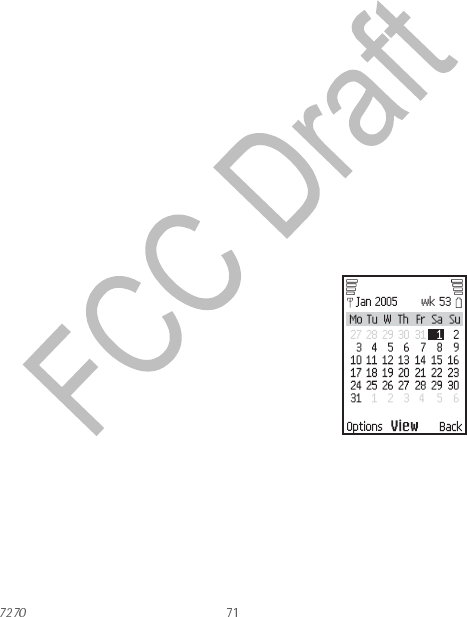
Nokia User Guide Copyright © 2004 Nokia
Organizer
Turn off an alarm setting
Select Menu > Organizer > Alarm clock > Alarm time > Off.
When the alarm sounds
WITH THE PHONE ON
The phone sounds an alert tone, flashes Alarm!, and shows the current time.
Select Stop to shut the alarm off, or select Snooze to stop the alarm for 10
minutes.
If the fold is closed, press either of the volume keys to set the alarm to snooze.
WITH THE PHONE OFF
If the alarm time is reached while the device is switched off, the device
switches itself on and starts sounding the alarm tone. If you select Stop, the
device asks whether you want to activate the device for calls. Select No to turn
off the device or Yes to make and receive calls. Do not select Yes when wireless
phone use may cause interference or danger.
•Calendar
The calendar keeps track of reminders, calls you need to make, meetings, and
birthdays. It can even sound an alarm for any of these events.
Open the Calendar
Select Menu > Organizer > Calendar.
The month view of the calendar appears in the display
with the current date highlighted. You can move to
another date by using the four-way scroll keys like a
joystick.
The month view provides an overview of the selected
month and weeks. It also allows you to jump to a
specific date. Any days or dates that appear in bold
font contain calendar notes such as a meeting or
reminder.
While in the month view, to display the week view,
select Options > Week view..
Calendar settings
In either the month view or the week view, select Options > Settings, and one
of the listed options, and follow the prompts.

72 Copyright © 2004 Nokia
You can set the phone to delete calendar notes automatically after a day, a
week, or a month, or to never delete notes. Even if you set the phone for
automatic deletion, repeating notes such as birthdays are not deleted.
Go to a date
1In either the month view or the week view, select Options > Go to date.
2Enter the date (for example, 01/05/2004), and select OK.
The month or week view appears in the display with the jump date
highlighted.
Make a calendar note
You can choose from five types of notes: Meeting, Call, Birthday, Memo, and
Reminder. Your phone asks for further information depending on which note
you choose. You can also set an alarm, with or without an alarm tone, for any
note.
1Go to the date for which you want to make a note, and select Options >
Make a note and one of the listed types of notes.
2Enter the information requested by the prompts.
View calendar notes (the day view)
Any dates that contain calendar notes are in bold (in the month view) or display
a note icon (in the week view).
1Go to the date containing the note, and select View.
The headers of any notes you have for the day appear in a list format.
2Scroll to the desired note, and select View.
The body of the note appears in the display.
Calendar note options
While viewing the header or the body of a note, select Options and one of the
following:
Make a note, Delete, Edit, Move, Go to date, Copy, Go to to-do list
Repeat—Make the note recur on a regular basis (daily, weekly, biweekly,
monthly, and yearly).
Send note—Send the note to another device using IR mobile link, as a text or
multimedia message or as a note to another compatible phone calendar.
Settings—Set the date and time, date and time format, the day each week starts,
and whether you want your notes to autodelete after a specified time.

Nokia User Guide Copyright © 2004 Nokia
Organizer
When a note alarm sounds
The phone beeps and displays the note. When a call note is displayed, you can
call the displayed number by pressing Call.
To stop the alarm without viewing the note, select Exit.
To stop the alarm and view the note, select View. Select Snooze; the phone
returns to the start screen and sounds an alarm again after 10 minutes.
If the fold is closed, press either of the volume keys to mute the note alarm.
Send a calendar note
1Go to the date with the note you want to send, select View, and the note.
2Select Options > Send note > Via calendar, Via multimedia, Via text
message, or Via Infrared.
3Follow the prompts to send the note.
Receive calendar notes
When you receive a calendar note, your phone displays Calendar note received.
You can then save the note in your calendar if desired, and set an alarm for any
date and time.
1When your phone displays Calendar note received, select Show; then use
the scroll keys to view the entire message, if necessary.
2To save the calendar note, select Options > Save, or to discard the
calendar note, select Options > Discard.
•To-do list
Use the to-do list feature to keep track of your tasks. You can save a note for a
task, select a priority level for the note, and mark it as done when you have
completed it. You can sort the notes by priority or by date.
Add a to-do note
1Select Menu > Organizer > To-do list.
2If there are no notes, select Add note; if there are notes, select Options >
Add.
3Enter the subject of the to-do note, and select Save.
4Select either High, Medium, or Low priority.
The to-do note is saved. The phone automatically sets the deadline without
an alarm.

74 Copyright © 2004 Nokia
View a to-do note
Select Menu > Organizer > To-do list, scroll to a to-do note, and select View.
Options while viewing to-do notes
Select Options while viewing the header or body of a particular note and the
following options appear:
Add, Deadline, Delete, Sort by deadline, Go to calendar, Save to calendar,
Delete all notes
Mark note as done—Mark a note or task as complete; no more reminders will
follow.
Send—Send the note to another device using IR, as a text or multimedia
message, or as a calendar note to another compatible phone.
Edit priority—Change the priority to high, medium, or low (available only in body
view).
•Notes
You can use the notes application to write and send notes to compatible
devices using IR or as a text message or multimedia message.
Make a note
1Select Menu > Organizer > Notes.
2If there are no notes, select Add note; or if there are notes, select
Options > Make a note.
3Enter the text of the note.
4While entering text, select Options, and follow the prompts.
Send a note
1Highlight the note you want to send, and select Options > Send note >
Via infrared, Via text message, or Via multimedia.
2Follow the prompts to send the note.
•Synchronization
The phone synchronization feature is a network service that allows you to
synchronize the calendar and contacts in your phone with a remote Internet
server or a compatible PC. If you have saved data in the remote Internet server,
you can synchronize your phone by starting the synchronization from the
phone. You can also synchronize your phone contacts and calendar to

Nokia User Guide Copyright © 2004 Nokia
Organizer
correspond with the data of a compatible PC by starting the synchronization
from the PC. You must install Nokia PC Suite on your PC to use this feature. See
“Nokia PC Suite” on page 11 for more information.
Contacts in your SIM card will not be synchronized.
Answering an incoming call during synchronization will end synchronization
and you will need to restart it.
This feature must be supported by your service provider. For more information
on availability and synchronization service settings, contact your service
provider.
Save settings
You may receive the synchronization settings as a settings message or you may
need to enter the synchronization settings manually.
SAVE SETTINGS RECEIVED AS A SETTINGS MESSAGE
When you receive the synchronization settings as a settings message,
Synchronization settings received is displayed.
Select Options > Details, Save, or Discard.
SAVE SETTINGS MANUALLY
You need to activate the set where you want to save the synchronization
settings. A set is a collection of settings required to make a connection to a
service. Contact your service provider for the settings.
1Select Menu > Organizer > Synchronization > Server sync > Sync server
settings and each of the following:
Configuration—Select Default or Personal config. depending on which
configuration settings support the synchronization. See “Configuration
settings” on page 58.
Account—Select a service account contained in the active configuration
settings.
2Select PC sync. settings and each of the following:
User name—Enter the user name, and select OK. (Contact your service
provider, if necessary, for this information.)
Password—Enter the password, and select OK. (Contact your service
provider, if necessary, for this information.)
The user name and password must be the same in the phone and in the PC.

76 Copyright © 2004 Nokia
Synchronize with a remote Internet server
If you have saved data in the remote Internet server, you can synchronize your
phone by starting the synchronization from your phone. Once you have
customized and selected the appropriate synchronization settings, you are
ready to synchronize data. (See “Save settings” on page 75 or “Save settings
manually” on page 75 for more information.)
SYNCHRONIZE DATA
1Select Menu > Organizer > Synchronization > Server sync > Data to be
synchronized.
2Mark the data to be synchronized.
3Select Menu > Organizer > Synchronization > Server sync >
Synchronize.
Synchronization begins.
Depending on the type of connection you are using to synchronize data,
connecting or initializing messages may appear.
Synchronizing for the first time or after an interrupted synchronization may
take up to 30 minutes, if contacts or calendar are full.
STOP SYNCHRONIZATION
1To stop synchronization, select End call, or press End.
2At the Quit synchronization? prompt, select OK.
HANDLE CALLS DURING SYNCHRONIZATION
During synchronization, outgoing calls are not possible. Incoming calls can still
be received, and can be handled in one of the following ways:
• To reject the incoming call, press End. Synchronization continues.
• To answer the incoming call, press Call. Synchronization is interrupted and
a Synchronization suspended message appears.
Once the incoming call is ended, a Start synchronization again? message
appears. Select Yes to start synchronization again from the beginning.
Synchronize with your PC
You can synchronize the data in contacts and calendar to correspond with the
data of your PC by starting the synchronization from your PC. To synchronize
data from your PC, use either an IR connection or a data cable. You also need
the Nokia PC Suite software installed on your PC.
Start the synchronization from your PC using Nokia PC suite. For more
information, see the Nokia PC Suite online help. After synchronizing, the data
in the phone and in the PC are the same.

Nokia User Guide Copyright © 2004 Nokia
Organizer
•Wallet
The wallet feature allows you to store personal information like debit and credit
card information to an encrypted area of phone memory. This information can
then be used to make secure online purchases. Wallet purchases can also use
digital signatures enabled by a security module in the SIM card (if present) for
signing and verifying transactions. Online purchases and digital signature
capabilities depend on your service provider.
You can also store personal information such as PIN codes and other sensitive
data in a wallet personal note.
You must enter a wallet code each time you access wallet. If you do not use
wallet for 5 minutes, it is automatically closed.
Create a wallet code
The first time you access wallet, you must create a personalized wallet code.
1Select Menu > Organizer > Wallet.
2At the prompt, enter the 4–10 digit code of your choice, and select OK.
3Enter the same code again for verification, and select OK.
Create a code that is unique, yet easy to remember. This will be your key to
using wallet features in the future. Also, keep your wallet code in a secret place,
separate from your phone.
If you enter an incorrect wallet code three times in succession, you cannot
access wallet for 5 minutes.
Change the wallet code
1Select Menu > Organizer > Wallet.
2At the prompt, enter your wallet code, and select OK > Settings > Change
code.
3Enter the original wallet code, and select OK.
4Enter the new wallet code, and select OK.
5Enter the new wallet code again for verification, and select OK.
Reset the wallet code
If you forget your wallet code, you can reset the code and to erase all the
information stored in wallet.
Once you reset the wallet code and clear the contents of wallet, all of the
information is deleted. You must manually enter the information to restore it.
1At the start screen, enter *#7370925538# (*#res wallet#).

78 Copyright © 2004 Nokia
2At the prompt, select Yes.
3Enter your security code, and select OK.
Wallet menu
1Select Menu > Organizer > Wallet.
2At the prompt, enter your wallet code, and select OK and one of the
following:
Wallet profiles—Create card combinations for different services.
Cards—Save personal card information. See “Create a wallet card” on
page 78.
Tickets—Save notifications of e-tickets that you have bought through a
mobile service.
Receipts—Save receipts for mobile purchases.
Personal notes—Save any personal information that you want to protect
with the wallet code.
Settings—Set and change the wallet settings.
•Change code—Change the wallet code.
•RFID—Set the radio frequency identification (RFID) code. The RFID
technology helps to securely conduct commerce transactions with
your phone. You can enter the RFID code and the RFID type.
Create a wallet card
Wallet supports several categories of cards.
1Access the wallet, and select Cards and one of the following:
Payment cards—for credit and debit cards.
Loyalty cards—for membership cards.
Access cards—for personal user names and passwords to online services.
User info cards—for customized personal preferences for online services.
Address cards—for contact information such as delivery and billing
addresses.
2If there are no cards in that category, select Add new; if there are cards,
select Options > Add new and follow the prompts.
3When you are finished, select Done.
If supported by your service provider, you can also receive card information as
a message. You are notified which category the card belongs to. Save or discard
the received card. You can view and rename the saved card, but you cannot edit
it. Contact your service provider for more information.

Nokia User Guide Copyright © 2004 Nokia
Organizer
Compose a personal note
Wallet can store up to 30 personal notes, such as passcodes or other sensitive
data. Your notes are protected by the wallet security feature.
1Access the wallet, and select Personal notes.
2If there are no notes in the list, select Add new; if there are notes in the
list, select Options > Add new.
3Compose your note, and select OK.
4Enter a title for the note, and select OK.
Note options
While viewing note headers, select View to view the contents of the selected
note, or select Options > Edit, Add new, Sort, Delete, or Delete all.
While viewing the contents of a note, select Edit to edit the note, or select
Options > Send via text msg., Copy to calendar, Use detail, or Delete.
Create a wallet profile
When you have saved your personal card details, you can combine them into a
wallet profile. You can use the profile to retrieve wallet data from different
cards while browsing.
1Access the wallet, and select Wallet profiles.
2If there are no wallet profiles, select Add new; if there are wallet profiles,
select Options > Add new.
3Follow the prompts to select a payment card, aloyalty card list, an access
card, a user info card, a billing address, a shipping address, a receipt delivery
address, and a receipt delivery method (either To phone number or To
e-mail address).
4At the Wallet profile name prompt, enter a name for the profile, and select
OK.
Guidelines for making purchases with wallet
To shop, access the desired service site that supports wallet. See “Mobile
Internet services” on page 87. The service must support the Electronic
Commerce Modeling Language specification.
Choose the product you want to buy and read all information carefully.
When you indicate that you want to buy an item, the phone asks whether you
want to use wallet, and asks for your wallet code.
Select the card you want to use from the payment cards list. The phone
automatically fills in the credit card information or the wallet profile.

80 Copyright © 2004 Nokia
Approve the purchase, and the information is forwarded. You may receive an
acknowledgement or a digital receipt.
To close the wallet, select Close wallet.
If you have accessed or tried to access confidential information requiring
passwords, such as a bank account, empty the phone cache after each use. See
“Cache memory” on page 93.
•Calculator
Basic calculations
The calculator adds, subtracts, multiplies, divides, calculates the square and the
square root, and converts currency values.
Note: This calculator has limited accuracy and is designed for simple
calculations.
1Select Menu > Organizer > Calculator.
2In the calculator screen, enter the first number in the calculation.
Press # for a decimal point if necessary.
3To perform an arithmetic calculation, press * to cycle through the add (+),
subtract (-), multiply (*), and divide (/) characters, and pause briefly to
select the displayed character; then enter the second number in your
calculation, and select Equals.
4To perform a square or square root calculation, select Options > Square or
Square root.
The completed calculation appears in the display.
Currency conversion
You can convert foreign currency to home currency, or vice versa.
CREATE OR EDIT THE EXCHANGE RATE
1Select Menu > Organizer > Calculator > Options > Exchange rate and
one of the following:
Foreign units in home units—Enter the number of home units it takes to
make one unit of foreign currency.
Home units in foreign units—Enter the number of foreign units it takes to
make one unit of your home currency.
2Enter the exchange rate, and select OK.

Nokia User Guide Copyright © 2004 Nokia
Organizer
CONVERT CURRENCY
1Perform the currency conversion directly from the start screen, or select
Menu > Organizer > Calculator.
2Enter amount of currency to convert, select Options, and one of the
following:
To home—Converts foreign currency to domestic currency.
To foreign—Converts domestic currency to foreign currency.
The converted amount appears in the display.
•Stopwatch
Your phone has a stopwatch that can be used to track time at sporting events
or other occasions. While the stopwatch is running, if you press End and return
to the start screen, the clock continues to run in the background, and
appears in the upper left corner of the screen.
Using the stopwatch consumes the battery and reduces the operating time of
the phone. Be careful not to let it run in the background when performing other
operations with your phone.
Measure split time
You can use the split time function for such things as a long distance race when
you need to pace yourself.
1Select Menu > Organizer > Stopwatch > Split timing > Start.
2To take an intermediate time, select Split.
The timer continues to run. The split time appears below the running time.
If you split the time more than once, the new measured time appears at
the beginning of the list. You can scroll to see previous measured times.
3To stop timing, select Stop.
The total time appears at the top of the display.
Measure lap time
You can use the lap time function when you want to track how long it takes to
complete each cycle or lap.
1Select Menu > Organizer > Stopwatch > Lap timing > Start.
The running time appears on the screen.
2Select Lap to measure lap time.
The clock stops, then starts immediately from zero. The lap time appears

82 Copyright © 2004 Nokia
below the running time.
If you take more than one lap time, the new measured time appears at the
beginning of the list. You can scroll to see previous measured times.
3To stop timing, select Stop.
The total time appears at the top of the display.
Save the time
1While the clock is running, select Stop > Save.
2Enter a name for the measurement, and select OK.
If you do not enter a name, the total time is used as the default title for
the lap time.
•timer
The timer is like an egg-timer or the timer on your microwave oven. You can
enter a specified time (up to 99 hours and 59 minutes), and when the time runs
out, your phone sounds an alarm. The timer only works when the phone is on.
Once you turn off your phone, the timer is no longer active.
Set the timer
1Select Menu > Organizer > Timer.
2At the prompt, enter the time in hh:mm:ss format, and select OK.
3Enter a note for the timer, and select Start.
The timer begins running. The icon appears in the upper left corner of
the start screen.
Change the time
After you have set the timer, you can change the time.
1Select Menu > Organizer > Timer > Change time.
2Enter the new time in hh:mm:ss format, and select OK.
The timer begins running.
Timer alarm
When the time runs out, your phone sounds an alarm and displays the timer
note or Countdown completed.
To stop the timer, press any key during the alarm. To stop the alarm and delete
the text note, select Exit.

Nokia User Guide Copyright © 2004 Nokia
Organizer
If you do not respond to the timer alert, it expires automatically after 30
seconds.
Stop the timer before the alarm sounds
Select Menu > Organizer > Timer > Stop timer.
Timer stopped appears in the display.

84 Copyright © 2004 Nokia
12 Applications
Your phone supports J2ME™ Java applications. You will find some
Java applications and games pre-installed on your phone. Also, you
can manage and download new applications and games from your service
provider.
Running some applications and games may consume the battery faster. You
may need to connect the phone to the charger.
•Games
Start a game
1Select Menu > Applications > Games > Select game, a game, and Open.
2To begin a new game, select New game.
3To read the games rules, select Instructions.
Options
While viewing the games list, select Options to display the following options:
Delete—Delete the game.
Details—Display details of the game.
Update version—Check if a new version of the game is available for download.
Web page—Get more information or additional data from a mobile Internet
page. This feature is shown only if it is supported by the network and a mobile
internet address has been provided by the game.
App. access—Choose whether the game should be allowed to access the network.
You can require that the game ask every time it tries to access the network, ask
only the first time, always access the network without asking, or never access the
network.
Downloads
Your phone supports J2ME Java applications. During downloading the
compatibility is checked, and the downloading is interrupted if the phone does
not support the application.
1Select Menu > Applications > Games > Game downloads and one of the
bookmarks displayed.
To access the list of bookmarks in the Web menu, select More bookmarks.
2Select Select.

Nokia User Guide Copyright © 2004 Nokia
Applications
The phone connects to the Web pages using the currently active set of
browser settings. If the connection fails, you may enter the Web menu and
activate another set of service settings. See “Set up for browsing” on
page 87.
When downloading a game, it may be saved in the Collection menu instead of
the Games menu.
Settings
You can turn game sounds, lights, and vibration on or off.
1Select Menu > Applications > Games > App. settings.
2Select Application sounds or Application shakes > On or Off; or select
Application lights > App. defined or Default.
• Collection
Start an application
1Select Menu > Applications > Collection > Select application.
2Scroll to an application or an application set, and select Open.
If the selection is a single application, the application starts. Otherwise, a
list of applications within the selected application set appears in the
display.
3To start a single application, scroll to the desired application, and select
Open.
Options
While viewing the application list, select Options to display the following
options.
Delete—Delete the application or application set from your phone. If you delete
a pre-installed application or application set, you may be able to download it
again from www.nokia.com/us.
Details—Shows additional information about the application.
Update version—Check if a new version of the application is available for
download.
Web page—Get further information or additional data for the application from
a mobile Internet page. This feature must be supported by a service provider. It
is only shown if a mobile Internet address has been provided with the
application.

86 Copyright © 2004 Nokia
App. access—Choose whether the application should be allowed to access the
network. You can require that the application ask every time it tries to access
the network, ask only the first time, always access the network without asking,
or never access the network.
Downloads
Note: Only install sources that offer adequate protection against
harmful software. Downloading applications is a network service.
Contact your service provider for more information
Your phone supports J2ME Java applications. During downloading the
compatibility is checked, and the downloading is interrupted if the phone does
not support the application.
When you download games or applications, games may be saved in the
Collection menu and applications may be saved in the Games menu.
APPLICATIONS
1Select Menu > Applications > Collection > App. downloads.
A list of available browser bookmarks appears in the display.
2Select More bookmarks to access the list of browser bookmarks in your
Web menu.
3Select the bookmark that contains the application you wish to download.
The phone connects to the Web page. See “Navigate the mobile Internet”
on page 88 for information on browsing Web pages. If the connection fails,
you may enter the Web menu and activate another set of service settings.
See “Set up for browsing” on page 87.
LINKS
Select Menu > Web > Download links > App. downloads and one of the sites
from the list.

Nokia User Guide Copyright © 2004 Nokia
Mobile Internet services
13 Mobile Internet services
The browser on your phone can display content that uses wireless
mark-up language (WML) or extensible hypertext mark-up language
(XHTML). The browser supports WAP 2.0 protocols (HTTP and SSL) that run on
TCP and IP protocols.
This feature is a network service. Contact your service provider for more
information.
Because mobile Internet content is designed to be viewed from your phone,
your service provider is now your mobile Internet service provider as well.
It is likely that your service provider has created a home page and set up your
browser to go to this page when you log on to the mobile Internet. Once at your
service provider’s home page, you may find links to a number of other sites.
• Set up for browsing
It may not be necessary to manually configure the browser on your phone if
this was done by your service provider when you subscribed to the feature.
You may receive the service settings as a connection settings message from
your service provider. See “Connection settings service” on page 11.
You can enter the settings manually or add and edit the settings with Nokia PC
Suite.
To enter the settings manually, select Menu > Web > Settings >
Configuration settings and each of the following:
Configuration—Select Default or Personal config. depending on which
configuration settings support the service. See “Configuration settings” on
page 58.
Account—Select a service account contained in the active configuration
settings.
Display terminal window—Select Yes to perform manual user authentication
for intranet connections.
Contact your service provider if you have problems using the browser.
Activate service settings for the desired service
Select Menu > Web > Settings > Connections settings >
Active service settings, scroll to the desired service, and select Activate.
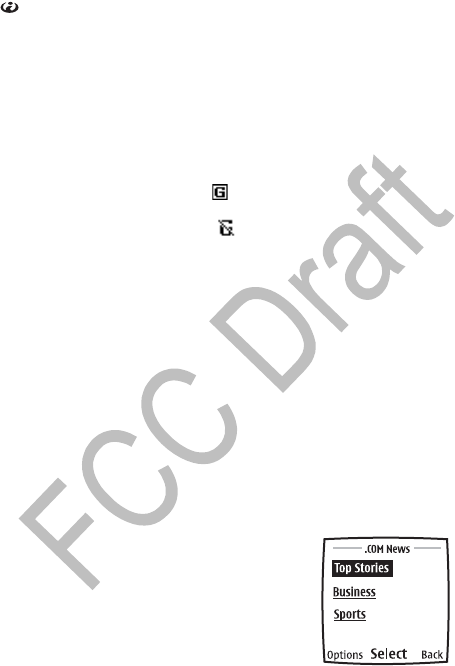
88 Copyright © 2004 Nokia
Connect to the web
To open the web start page, at the start screen, press and hold 0 (the Internet
icon ).
To select a bookmark, select Menu > Web > Bookmarks, and a bookmark from
the list. If the bookmark does not work with the current active service settings,
activate another set of service settings and try again.
After a brief pause, the phone attempts to connect to your service provider’s
home page or to the address that you selected.
If you see Check service settings, the phone may not be set up for browsing.
Contact your service provider to make sure that your phone is configured
properly.
If GPRS is selected as the data bearer, is shown in the upper left corner of
the display during browsing. If you make a call or receive a call or text message,
the GPRS connection is suspended and is shown in the upper right corner
of the display. After the call, the phone tries to reestablish the GPRS
connection.
Navigate the mobile Internet
Since your phone screen is much smaller than a computer screen, mobile Internet
content is displayed differently from content displayed on a computer. This
section contains guidelines for using phone keys to navigate a mobile Internet
site.
• To browse the site, use any of the scroll keys.
• To select a highlighted item, press Call or select Open.
• To enter letters and numbers, press a key from 0–9.
• To enter special characters, press *.
The following illustration shows some common elements you may find on a
mobile Internet site. These are examples only.
1) Header line. Shows the current mobile Internet
site.
2) Active link. Appears as a highlighted word.
3) Inactive link. Appears as an underlined word.
Scroll up and down through the list of links.
4) Options. Select Options to go to the list of
service options. See “Options while online” on
page 91.
5) Select. Select Select to go to the active link.
1)
2)
3)
4) 5) 6)

Nokia User Guide Copyright © 2004 Nokia
Mobile Internet services
6) Back. Select Back to return to the previous page.
Appearance settings
You can determine how pages appear on the phone display.
1Select Menu > Web > Settings > Appearance settings; or while
browsing, select Options > Other options > Appear. settings.
2Select one of the following options:
Text wrapping—Text on the Web page continues on the next line if it
cannot be shown on only one line. Select On to allow text wrapping, or Off
to prevent text wrapping.
Font size—Select Small, Normal, or Large.
Show images—Select Yes to display pictures from the page or No to hide
pictures. When pictures are displayed, pages load more slowly.
Alerts—The phone can alert you to unsecure connections and to unsecure
items on secure pages. However, these alerts do not guarantee a secure
connection.
•Alert for unsecure connection—Select Yes to set the phone to alert you
when a secure connection changes to an unsecure connection during
browsing.
•Alert for unsecure items—Select Yes to set the phone to alert you
when a secure page contains an unsecure item.
Character encoding—Select encoding methods for Web content and Web
addresses.
•Content encoding—Select the character set that the phone uses to
display browser pages that do not include that information.
•Unicode (UTF-8) web addresses—Determine whether to always use
UTF-8 encoding when sending a Web address to a compatible phone.
Select On or Off.
Bookmarks
You can save addresses for your favorite sites as bookmarks.
Your device may have some bookmarks loaded for sites not affiliated with
Nokia. Nokia does not warrant or endorse these sites. If you choose to access
them, you should take the same precautions, for security or content, as you
would with any mobile Internet site.
SET BOOKMARKS MANUALLY
1Select Menu > Web > Bookmarks.
2If there are no bookmarks in the list, select New; or if there are bookmarks
in the list, select Options > New bookmark.

90 Copyright © 2004 Nokia
3Enter an address for the bookmark, and select OK.
4Enter a title for the bookmark, and select OK.
SET BOOKMARKS WHILE ONLINE
While you are connected to the site that you want to bookmark, select
Options > Add bookmark.
RECEIVE A BOOKMARK
When you receive a bookmark, 1 bookmark received is displayed. Select
Show > Save to save the bookmark, or Options > View or Delete to view or
delete it.
• Service inbox
You can receive service messages (pushed messages) from your service provider.
Service message settings
Select Menu > Web > Settings > Service inbox settings and one of the
following:
Service messages—Select On to receive service messages, or Off to reject them.
Message filter—Select On to set the phone to receive messages only from
content authors approved by the service provider. Select Trusted channels to
view the list of approved content authors.
Automatic connection —Select On to automatically activate the browser from
the start screen when a service message is received; or Off to activate the
browser only when you select Retrieve after a service message is received.
View a service message
When you receive a service message, a note appears in the display. To view the
message:
1At the start screen, select Show to view the message immediately, or Exit
to save it to the service inbox for later viewing.
2While browsing, select Options > Other options > Service inbox.
To view a saved service message:
1Select Menu > Web > Service inbox.
2Scroll to the desired message, and select Options and one of the following:
Retrieve—Activate the browser, and download the content indicated in the
message.
Details—View the details of the message.

Nokia User Guide Copyright © 2004 Nokia
Mobile Internet services
Delete—Delete the message.
• File download
You can download tones, images, games, and applications from the mobile
Internet.
1Select Menu > Web > Download links; or while browsing, select
Options > Download links.
2Select a download option; then select one of the sites from the list and
follow the prompts.
• Disconnect from the mobile Internet
To close your connection, press End twice, or press and hold End; or select
Options > End call > Yes.
• Make an emergency call while online
If you are using GPRS to connect to the mobile Internet, you can end your data
connection and then make an emergency call.
1To close your mobile Internet connection, press End twice.
2Enter the emergency number (for example, 911), and press Call.
• Options while online
While you are connected to the mobile Internet, select Options to access the
following options. Some service providers may have customized these options.
Contact your service provider for more information if any of the following
options are not available.
Use wallet info—Use the wallet card information from the wallet application,
if the service page supports wallet. See “Wallet” on page 77.
Shortcuts—Open a new list of options, for example, options specific to the current
page.
Home—Go to the service home page.
Add bookmark—Saves the current page as a bookmark.
Bookmarks—Shows a list of all saved bookmarks. Bookmarks help you find a
mobile Internet site quickly.

92 Copyright © 2004 Nokia
Download links—Show the list of bookmarks for downloading tones, graphics,
games, or applications.
Save to folder—Add a bookmark for the current site to the list of bookmarks
for downloading tones, graphics, games, videos, or applications. The bookmark
then appears in the appropriate folder in the Download links submenu.
Other options—Show a list of other options, such as appearance and security
options.
Reload—Reload and update the current page.
End call—Disconnect from a service.
The browser supports functions that you can access while browsing. You can
make a voice call, send touch tones while a voice call is in progress, and save a
name and phone number from a page.
•Security
Security features may be required for some services, such as banking or
shopping. For such connections you need security certificates and possibly a
security module which may be available on your SIM card. For more
information, contact your service provider.
Security module
The security module improves security services and allows you to use a digital
signature. It can contain certificates and public and private keys. Your service
provider saves the certificates in the security module.
Select Menu > Web > Settings > Security settings > Security module
settings and one of the following:
Security module details—View the security module title, status, manufacturer,
and serial number.
Module PIN request—Select On to set the phone to ask for the module PIN
when using services provided by the security module.
Change module PIN—Change the module PIN, if allowed by the security
module.
Change signing PIN—Select and change a signing PIN.
Digital signature

Nokia User Guide Copyright © 2004 Nokia
Mobile Internet services
You can make digital signatures with your phone if your SIM card has a security
module. The signature can be traced back to you through the private key on the
security module and the user certificate that was used to perform the
signature. Using the digital signature can be the same as signing your name to
a paper bill, contract, or other document.
1While browsing, select a link on a page, such as the title of the book you
want to buy and its price.
The text to sign (possibly including amount, date, etc.) is shown.
2Check that the header text is Read and that the digital signature icon
is shown.
If the digital signature icon does not appear, there is a security breach. Do
not enter any personal data such as your signing PIN.
3Scroll through and read all of the text before signing.
4To sign the text, select Sign.
5Select the user certificate you want to use, enter the signing PIN (provided
with the SIM card if the SIM card has a security module), and select OK.
The digital signature icon disappears, and the service may display a
confirmation of your purchase.
Cache memory
The information or services you access with the browser are temporarily saved in
the cache memory of the phone.
If you tried to access or have accessed confidential information requiring
passwords (for example, your bank account), clear the cache after each use.
To clear the cache from the menu, select Web > Clear the cache.
To clear the cache while browsing, select Options > Other options > Clear the
cache.
Certificates
There are three kinds of certificates—server, authority, and user.
Certificates have a restricted lifetime. If Expired certificate or Certificate not
valid yet is shown even though the certificate should be valid, check that the
current date and time settings in your phone are correct. Before changing these
settings, make sure that you really trust the owner of the certificate and that
the certificate really belongs to the listed owner.

94 Copyright © 2004 Nokia
SERVER CERTIFICATES
The phone uses a server certificate to create a connection with improved
security between the phone and the content server. The phone receives the
server certificate from the service provider before the connection is established.
The validity of the server certificate is checked using the authority certificates
saved in the phone. Server certificates are not saved.
AUTHORITY CERTIFICATES
Authority certificates are used by some services, such as banking, for checking
the validity of other certificates. Authority certificates can be saved in the
security module by the service provider, or they can be downloaded from the
network if the service supports the use of authority certificates.
To view authority certificates, select Web > Settings > Security settings >
Authority certificates > Certificate list, scroll to the desired certificate, and
select View.
USER CERTIFICATES
User certificates are issued to users by a certifying authority. User certificates
are required to make a digital signature. They associate the user with a specific
private key in a security module.
To view user certificates, select Web > Settings > Security settings > User
certificates > Certificate list, scroll to the desired certificate, and select View.
Cookies
A cookie is data that a Web site saves in your phone browser cache memory.
The data can be, for example, your user information or your browsing
preferences. Cookies will be saved until you clear the cache memory.
1Select Menu > Web > Settings > Security settings > Cookies; or while
browsing, select Options > Other options > Security > Cookie settings.
2Select Allow to accept cookies or Reject to reject cookies.
Scripts over secure connection
To allow scripts from a secure page to be run, do one of the following:
• In the start screen, select Menu > Web > Settings > Security settings >
Scripts over secure connection > Allow.
• While browsing, select Options > Other options > Security > Script
settings > Allow.

Nokia User Guide Copyright © 2004 Nokia
SIM services
14 SIM services
In addition to the functions available on the phone, your SIM card
may provide additional services that you can access through the SIM
services menu. This menu is shown only if it is supported by your SIM card. The
name and contents of the menu depend entirely on the service available. For
availability, rates, and information on using SIM services, contact your service
provider.
To see the messages sent between the phone and the network when you are
using the SIM services, select Settings > Phone settings > Confirm SIM
service actions > Yes.
Accessing these services may involve sending a text message or making a phone
call for which you may be charged.

96 Copyright © 2004 Nokia
15 Hardware and enhancements
• Hardware
Connection ports and other features
For the location of ports and other features of your phone, refer to “Nokia 7270
phone at a glance” on page i, “Phone introduction—fold closed” on page 6, and
“Phone introduction—fold open” on page 7.
The BL-4C battery provides up to 4 hours of talk time and up to 270 hours of
standby time. Operation times are estimates and may vary depending on
network conditions, charging, and use of various features.
• Enhancements
Your phone is compatible with the following Nokia mobile enhancements:
Power
• 760-mAh Li-Ion battery (BL-4C)
• Retractable travel charger (AC-1)
• Travel charger (ACP-12)
• Mobile charger (LCH-9)
• Mobile charger (LCH-12)
Data
• Data cable (DKU-2)
Audio
• Music stand (MD-1)
• Boom headset (HDB-4)
• Stereo headset (HS-3)
• Earbud headset (HS-5)
Accessibility
• Loopset (LPS-4)
• TTY/TTD phone adapter (HDA-10)
Car
• Plug-In Car Handsfree (HF-3)
• Headrest handsfree (BHF-3)

Nokia User Guide Copyright © 2004 Nokia
Hardware and enhancements
Body
• Image album (DD-1)
• Kaleidoscope (RX-11)

98 Copyright © 2004 Nokia

Nokia User Guide Copyright © 2004 Nokia
Reference Information
16 Reference Information
• Battery information
Charging and discharging
Your device is powered by a rechargeable battery. The full performance of a new
battery is achieved only after two or three complete charge and discharge
cycles. The battery can be charged and discharged hundreds of times but it will
eventually wear out. When the talk and standby times are noticeably shorter
than normal, buy a new battery. Use only Nokia approved batteries, and
recharge your battery only with Nokia approved chargers designated for this
device.
Unplug the charger from the electrical plug and the device when not in use. Do
not leave the battery connected to a charger. Overcharging may shorten its
lifetime. If left unused, a fully charged battery will lose its charge over time.
Temperature extremes can affect the ability of your battery to charge.
Use the battery only for its intended purpose. Never use any charger or battery
that is damaged.
Do not short-circuit the battery. Accidental short-circuiting can occur when a
metallic object such as a coin, clip, or pen causes direct connection of the
positive (+) and negative (-) terminals of the battery. (These look like metal
strips on the battery.) This might happen, for example, when you carry a spare
battery in your pocket or purse. Short-circuiting the terminals may damage the
battery or the connecting object.
Leaving the battery in hot or cold places, such as in a closed car in summer or
winter conditions, will reduce the capacity and lifetime of the battery. Always
try to keep the battery between 59°F and 77°F (15°C and 25°C). A device with
a hot or cold battery may not work temporarily, even when the battery is fully
charged. Battery performance is particularly limited in temperatures well below
freezing.
Do not dispose of batteries in a fire as they may explode. They may also explode
if damaged. Dispose of batteries according to local regulations. Please recycle
when possible. Do not dispose as household waste.

100 Copyright © 2004 Nokia
• Enhancements
A few practical rules about accessories and enhancements:
• Keep all accessories and enhancements out of the reach of small children.
• When you disconnect the power cord of any accessory or enhancement,
grasp and pull the plug, not the cord.
• Check regularly that enhancements installed in a vehicle are mounted and
are operating properly.
• Installation of any complex car enhancements must be made by qualified
personnel only.
• Enhancements, batteries, and chargers
Check the model number of any charger before use with this device. This device
is intended for use when supplied with power from AC-1, ACP-12, LCH-9, or
LCH-12 chargers.
Warning: Use only batteries, chargers, and enhancements approved by
Nokia for use with this particular model. The use of any other types
may invalidate any approval or warranty, and may be dangerous.
For availability of approved enhancements, please check with your dealer. When
you disconnect the power cord of any enhancement, grasp and pull the plug, not
the cord.
Your device and its enhancements may contain small parts. Keep them out of
reach of small children.
• Care and maintenance
Your device is a product of superior design and craftsmanship and should be
treated with care. The suggestions below will help you protect your warranty
coverage and enjoy your device for many years.
• Keep the phone and all of its parts and accessories out of the reach of small
children.
• Keep the device dry. Precipitation, humidity, and all types of liquids or
moisture can contain minerals that will corrode electronic circuits. If your
device does get wet, remove the battery and allow the device to dry
completely before replacing it.
• Do not use or store the device in dusty, dirty areas. Its moving parts and
electronic components can be damaged.
• Do not store the device in hot areas. High temperatures can shorten the

Nokia User Guide Copyright © 2004 Nokia
Reference Information
life of electronic devices, damage batteries, and warp or melt certain
plastics.
• Do not store the device in cold areas. When the device returns to its normal
temperature, moisture can form inside the device and damage electronic
circuit boards.
• Do not attempt to open the device other than as instructed in this guide.
• Do not drop, knock, or shake the device. Rough handling can break internal
circuit boards and fine mechanics.
• Do not use harsh chemicals, cleaning solvents, or strong detergents to
clean the device.
• Do not paint the device. Paint can clog the moving parts and prevent
proper operation.
• Use a soft, clean, dry cloth to clean any lenses (such as camera, proximity
sensor, and light sensor lenses).
• Use only the supplied or an approved replacement antenna. Unauthorized
antennas, modifications, or attachments could damage the device and
may violate regulations governing radio devices.
• Use chargers indoors.
All of the above suggestions apply equally to your device, battery, charger, or
any enhancement. If any device is not working properly, take it to the nearest
authorized service facility for service.
• Additional safety information
Operating environment
Remember to follow any special regulations in force in any area and always
switch off your device when its use is prohibited or when it may cause
interference or danger. Use the device only in its normal operating positions.
This device meets RF exposure guidelines when used either in the normal use
position against the ear or when positioned at least 5/8 inch (1.5 cm) away
from the body. When a carry case, belt clip, or holder is used for body-worn
operation, it should not contain metal and should position the device at least
5/8 inch (1.5 cm) away from your body.
In order to transmit data files or messages, this device requires a quality
connection to the network. In some cases, transmission of data files or
messages may be delayed until such a connection is available. Ensure the above
separation distance instructions are followed until the transmission is
completed.

102 Copyright © 2004 Nokia
Medical devices
Operation of any radio transmitting equipment, including wireless phones, may
interfere with the functionality of inadequately protected medical devices.
Consult a physician or the manufacturer of the medical device to determine if
they are adequately shielded from external RF energy or if you have any
questions. Switch off your phone in health care facilities when any regulations
posted in these areas instruct you to do so. Hospitals or health care facilities
may be using equipment that could be sensitive to external RF energy.
PACEMAKERS
Pacemaker manufacturers recommend that a minimum separation of 6 inches
(15.3 cm) be maintained between a wireless phone and a pacemaker to avoid
potential interference with the pacemaker. These recommendations are
consistent with the independent research by and recommendations of Wireless
Technology Research. To minimize the potential for interference, persons with
pacemakers should
• Always keep the device more than 6 inches (15.3 cm) from their
pacemaker when the device is switched on
• Not carry the device in a breast pocket
• Hold the device to the ear opposite the pacemaker
If you have any reason to suspect that interference is taking place, switch off
your device immediately.
HEARING AID
Some digital wireless devices may interfere with some hearing aids. If
interference occurs, consult your service provider.
Vehicles
RF signals may affect improperly installed or inadequately shielded electronic
systems in motor vehicles such as electronic fuel injection systems, electronic
antiskid (antilock) braking systems, electronic speed control systems, air bag
systems. For more information, check with the manufacturer or its
representative of your vehicle or any equipment that has been added.
Only qualified personnel should service the device, or install the device in a
vehicle. Faulty installation or service may be dangerous and may invalidate any
warranty that may apply to the device. Check regularly that all wireless device
equipment in your vehicle is mounted and operating properly. Do not store or
carry flammable liquids, gases, or explosive materials in the same compartment
as the device, its parts, or enhancements. For vehicles equipped with an air bag,
remember that an air bags inflate with great force. Do not place objects,

Nokia User Guide Copyright © 2004 Nokia
Reference Information
including installed or portable wireless equipment in the area over the air bag
or in the air bag deployment area. If in-vehicle wireless equipment is improperly
installed and the air bag inflates, serious injury could result.
Potentially explosive environments
Switch off your device when in any area with a potentially explosive atmosphere
and obey all signs and instructions. Potentially explosive atmospheres include
areas where you would normally be advised to turn off your vehicle engine.
Sparks in such areas could cause an explosion or fire resulting in bodily injury or
even death. Switch off the device at refuelling points such as near gas pumps at
service stations. Observe restrictions on the use of radio equipment in fuel depots,
storage, and distribution areas, chemical plants or where blasting operations are
in progress. Areas with a potentially explosive atmosphere are often but not
always clearly marked. They include below deck on boats, chemical transfer or
storage facilities, vehicles using liquefied petroleum gas (such as propane or
butane), and areas where the air contains chemicals or particles such as grain,
dust or metal powders.
FCC regulations prohibit using your wireless device while in the air. The use of
wireless telephones in an aircraft may be dangerous to the operation of the
aircraft, disrupt the wireless telephone network, and may be illegal.
Failure to observe these instructions may lead to suspension or denial of
telephone services to the offender, legal action, or both.
EMERGENCY CALLS
Important: Wireless phones, including this phone, operate using radio
signals, wireless networks, landline networks, and user-programmed
functions. Because of this, connections in all conditions cannot be
guaranteed. You should never rely solely on any wireless phone for
essential communications like medical emergencies.
To make an emergency call:
1If the phone is not on, switch it on. Check for adequate signal strength.
Some networks may require that a valid SIM card is properly inserted in
the phone.
2Press End as many times as needed to clear the display and ready the
phone for calls.
3Key in the official emergency number for your present location. Emergency
numbers vary by location.
4Press Call.
If certain features are in use, you may first need to turn those features off
before you can make an emergency call. Consult this guide or your service
provider. When making an emergency call, give all the necessary information as

104 Copyright © 2004 Nokia
accurately as possible. Your wireless phone may be the only means of
communication at the scene of an accident. Do not end the call until given
permission to do so.
CERTIFICATION INFORMATION (SAR)
THIS DEVICE MEETS THE GOVERNMENT’S REQUIREMENTS FOR EXPOSURE TO
RADIO WAVES.
Your mobile device is a radio transmitter and receiver. It is designed and
manufactured not to exceed the limits for exposure to radio frequency (RF)
energy adopted by the governments of the USA through the Federal
Communications Commission (FCC) and Canada through Industry Canada (IC).
These limits establish permitted levels of RF energy for the general population.
The guidelines are based on standards that were developed by independent
scientific organizations through periodic and thorough evaluation of scientific
studies. The standards include a substantial safety margin designed to assure
the safety of all persons, regardless of age and health.
The exposure guidelines for mobile devices employ a unit of measurement
known as the Specific Absorption Rate or SAR. The SAR limit adopted by the
USA and Canada is 1.6 watts/kilogram (W/kg) averaged over one gram of tissue.
The limit incorporates a substantial margin of safety to give additional
protection for the public and to account for any variations in measurements.
Tests for SAR are conducted using standard operating positions with the device
transmitting at its highest certified power level in all tested frequency bands.
The actual SAR level of an operating device can be well below the maximum
value because the device is designed to use only the power required to reach
the network. That amount changes depending on a number of factors such as
how close you are to a network base station.
The highest SAR value reported to the FCC and IC for this device type when
tested for use at the ear is 1.05 W/kg, and when properly worn on the body is
0.61 W/kg. SAR information on file with the FCC can be found under the Display
Grant section of http://www.fcc.gov/oet/fccid after searching on FCC ID
LJPRM-8. SAR values reported in other countries may vary depending on
differences in reporting and testing requirements and the network band.
Additional SAR information may be provided under product information at
http://www.nokia.com.
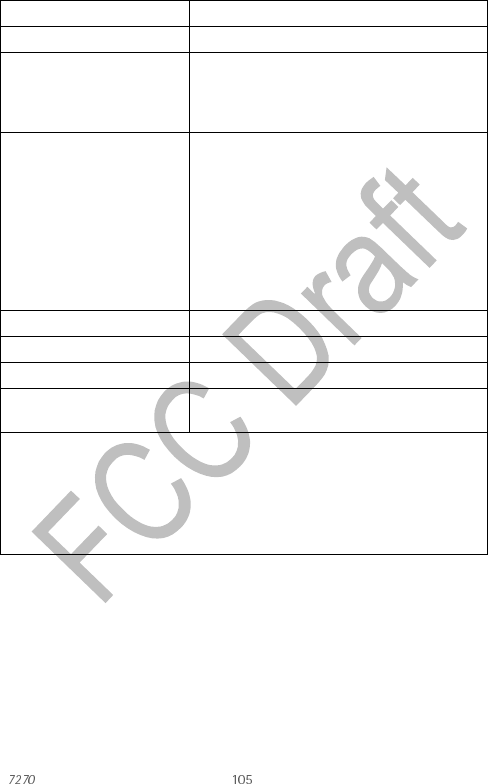
Nokia User Guide Copyright © 2004 Nokia
Reference Information
• Technical information
Feature Specification
Weight 4.27 oz (121 g) with 760 mAh BL-4C battery
Size Volume: 4.8 cubic inches (78 cc)
Length: 3.5 in (88 mm)
Width: 1.81 in (46 mm )
Thickness: 0.87 in (22 mm)
Frequency range Lowband
EGSM 900 880.2–914.8 MHz (TX)
925.2–959.8 MHz (RX)
Highband
GSM 1800 1710.2–1784.8 MHz (TX)
1805.2–1879.8 MHz (RX)
Highband
GSM 1900 1850.2–1909.8 MHz (TX)
1930.2–1989.8 MHz (RX)
Transmitter output power Up to 2 W
Battery voltage 3.7 V nominal
Operating temperature 14°F to + 131°F (-10°C to + 55°C)
aTalk time,
Standby time
Talk time: up to 2 hours
Standby time: up to 270 hours (11 days)
a. Battery talk and standby times are estimates only and depend on signal
strength, network conditions, features used, battery age and condition
(including the effect of charging habits), temperatures to which battery is
exposed, use in digital mode, and many other factors. Please note that the
amount of time a phone is used for calls will affect its standby time.
Likewise, the amount of time that the phone is turned on and in the start
screen will affect its talk time.

106 Copyright © 2004 Nokia
• Nokia ONE-YEAR LIMITED WARRANTY
Nokia Inc. (“Nokia”) warrants that this cellular phone (“Product”) is free from
defects in material and workmanship that result in Product failure during
normal usage, according to the following terms and conditions:
1The limited warranty for the Product extends for ONE (1) year beginning on
the date of the purchase of the Product. This one year period is extended
by each whole day that the Product is out of your possession for repair
under this warranty.
2The limited warranty extends only to the original purchaser (“Consumer”) of
the Product and is not assignable or transferable to any subsequent
purchaser/end-user.
3The limited warranty extends only to Consumers who purchase the Product
in the United States of America.
4During the limited warranty period, Nokia will repair, or replace, at Nokia’s
sole option, any defective parts, or any parts that will not properly operate
for their intended use with new or refurbished replacement items if such
repair or replacement is needed because of product malfunction or failure
during normal usage. No charge will be made to the Consumer for any such
parts. Nokia will also pay for the labor charges incurred by Nokia in
repairing or replacing the defective parts. The limited warranty does not
cover defects in appearance, cosmetic, decorative or structural items,
including framing, and any non-operative parts. Nokia’s limit of liability
under the limited warranty shall be the actual cash value of the Product at
the time the Consumer returns the Product for repair, determined by the
price paid by the Consumer for the Product less a reasonable amount for
usage. Nokia shall not be liable for any other losses or damages. These
remedies are the Consumer’s exclusive remedies for breach of warranty.
5Upon request from Nokia, the Consumer must prove the date of the
original purchase of the Product by a dated bill of sale or dated itemized
receipt.
6The Consumer shall bear the cost of shipping the Product to Nokia in
Melbourne, Florida. Nokia shall bear the cost of shipping the Product back
to the Consumer after the completion of service under this limited
warranty.
7The Consumer shall have no coverage or benefits under this limited
warranty if any of the following conditions are applicable:
a) The Product has been subjected to abnormal use, abnormal
conditions, improper storage, exposure to moisture or dampness,
unauthorized modifications, unauthorized connections, unauthorized
repair, misuse, neglect, abuse, accident, alteration, improper

Nokia User Guide Copyright © 2004 Nokia
Reference Information
installation, or other acts which are not the fault of Nokia, including
damage caused by shipping.
b) The Product has been damaged from external causes such as collision
with an object, or from fire, flooding, sand, dirt, windstorm, lightning,
earthquake or damage from exposure to weather conditions, an Act
of God, or battery leakage, theft, blown fuse, or improper use of any
electrical source, damage caused by computer or internet viruses,
bugs, worms, Trojan Horses, cancelbots or damage caused by the
connection to other products not recommended for interconnection
by Nokia.
c) Nokia was not advised in writing by the Consumer of the alleged
defect or malfunction of the Product within fourteen (14) days after
the expiration of the applicable limited warranty period.
d) The Product serial number plate or the enhancement data code has
been removed, defaced or altered.
e) The defect or damage was caused by the defective function of the
cellular system or by inadequate signal reception by the external
antenna, or viruses or other software problems introduced into the
Product.
8Nokia does not warrant uninterrupted or error-free operation of the
Product. If a problem develops during the limited warranty period, the
Consumer shall take the following step-by-step procedure:
a) The Consumer shall return the Product to the place of purchase for
repair or replacement processing.
b) If “a” is not convenient because of distance (more than 50 miles) or
for other good cause, the Consumer shall ship the Product prepaid and
insured to:
Nokia Inc., Attn: Repair Department
795 West Nasa Blvd.
Melbourne, FL 32901
c) The Consumer shall include a return address, daytime phone number
and/or fax number, complete description of the problem, proof of
purchase and service agreement (if applicable). Expenses related to
removing the Product from an installation are not covered under this
limited warranty.
d) The Consumer will be billed for any parts or labor charges not covered
by this limited warranty. The Consumer will be responsible for any
expenses related to reinstallation of the Product.
e) Nokia will repair the Product under the limited warranty within 30
days after receipt of the Product. If Nokia cannot perform repairs
covered under this limited warranty within 30 days, or after a

108 Copyright © 2004 Nokia
reasonable number of attempts to repair the same defect, Nokia at its
option, will provide a replacement Product or refund the purchase
price of the Product less a reasonable amount for usage. In some
states the Consumer may have the right to a loaner if the repair of the
Product takes more than ten (10) days. Please contact the Customer
Service Center at Nokia at the telephone number listed at the end of
this warranty if you need a loaner and the repair of the Product has
taken or is estimated to take more than ten (10) days.
f) If the Product is returned during the limited warranty period, but the
problem with the Product is not covered under the terms and
conditions of this limited warranty, the Consumer will be notified and
given an estimate of the charges the Consumer must pay to have the
Product repaired, with all shipping charges billed to the Consumer. If
the estimate is refused, the Product will be returned freight collect. If
the Product is returned after the expiration of the limited warranty
period, Nokia’s normal service policies shall apply and the Consumer
will be responsible for all shipping charges.
9You (the Consumer) understand that the product may consist of refurbished
equipment that contains used components, some of which have been
reprocessed. The used components comply with Product performance and
reliability specifications.
10 ANY IMPLIED WARRANTY OF MERCHANTABILITY, OR FITNESS FOR A
PARTICULAR PURPOSE OR USE, SHALL BE LIMITED TO THE DURATION OF
THE FOREGOING LIMITED WRITTEN WARRANTY. OTHERWISE, THE
FOREGOING LIMITED WARRANTY IS THE CONSUMER’S SOLE AND
EXCLUSIVE REMEDY AND IS IN LIEU OF ALL OTHER WARRANTIES, EXPRESS
OR IMPLIED. NOKIA SHALL NOT BE LIABLE FOR SPECIAL, INCIDENTAL,
PUNITIVE OR CONSEQUENTIAL DAMAGES, INCLUDING BUT NOT LIMITED
TO LOSS OF ANTICIPATED BENEFITS OR PROFITS, LOSS OF SAVINGS OR
REVENUE, LOSS OF DATA, PUNITIVE DAMAGES, LOSS OF USE OF THE
PRODUCT OR ANY ASSOCIATED EQUIPMENT, COST OF CAPITAL, COST OF
ANY SUBSTITUTE EQUIPMENT OR FACILITIES, DOWNTIME, THE CLAIMS OF
ANY THIRD PARTIES, INCLUDING CUSTOMERS, AND INJURY TO PROPERTY,
RESULTING FROM THE PURCHASE OR USE OF THE PRODUCT OR ARISING
FROM BREACH OF THE WARRANTY, BREACH OF CONTRACT, NEGLIGENCE,
STRICT TORT, OR ANY OTHER LEGAL OR EQUITABLE THEORY, EVEN IF NOKIA
KNEW OF THE LIKELIHOOD OF SUCH DAMAGES. NOKIA SHALL NOT BE
LIABLE FOR DELAY IN RENDERING SERVICE UNDER THE LIMITED
WARRANTY, OR LOSS OF USE DURING THE PERIOD THAT THE PRODUCT IS
BEING REPAIRED.

Nokia User Guide Copyright © 2004 Nokia
Reference Information
11 Some states do not allow limitation of how long an implied warranty lasts,
so the one year warranty limitation may not apply to you (the Consumer).
Some states do not allow the exclusion or limitation of incidental and
consequential damages, so certain of the above limitations or exclusions
may not apply to you (the Consumer). This limited warranty gives the
Consumer specific legal rights and the Consumer may also have other
rights which vary from state to state.
12 Nokia neither assumes nor authorizes any authorized service center or any
other person or entity to assume for it any other obligation or liability
beyond that which is expressly provided for in this limited warranty
including the provider or seller of any extended warranty or service
agreement.
13 This is the entire warranty between Nokia and the Consumer, and
supersedes all prior and contemporaneous agreements or understandings, oral
or written, relating to the Product, and no representation, promise or
condition not contained herein shall modify these terms.
14 This limited warranty allocates the risk of failure of the Product between
the Consumer and Nokia. The allocation is recognized by
the Consumer and is reflected in the purchase price.
15 Any action or lawsuit for breach of warranty must be commenced within
eighteen (18) months following purchase of the Product.
16 Questions concerning this limited warranty may be directed to:
Nokia Inc.
Attn: Customer Service
7725 Woodland Center Blvd., Ste. 150
Tampa, FL 33614
Telephone: 1-888-NOKIA-2U (1-888-665-4228)
Facsimile: (813) 249-9619
TTY/TDD Users Only: 1-800-24-NOKIA (1-800-246-6542)
17 The limited warranty period for Nokia supplied attachments and
accessories is specifically defined within their own warranty cards and
packaging.

110 Copyright © 2004 Nokia
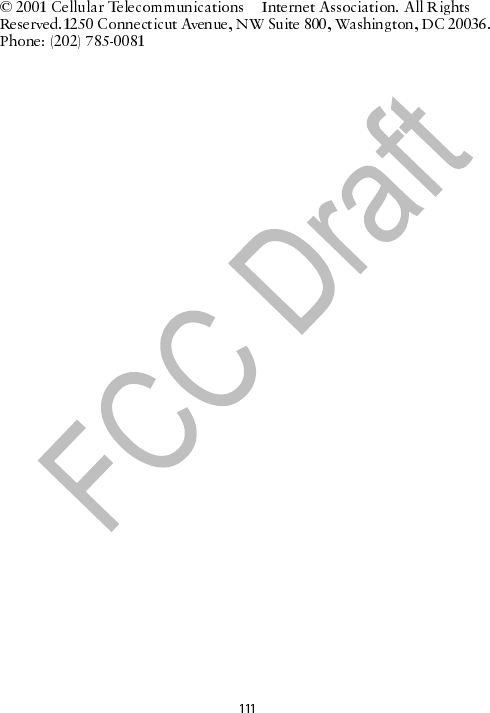
Appendix A Message from the CTIA
Appendix A Message from the CTIA
(Cellular Telecommunications & Internet
Association) to all users of mobile phones
&
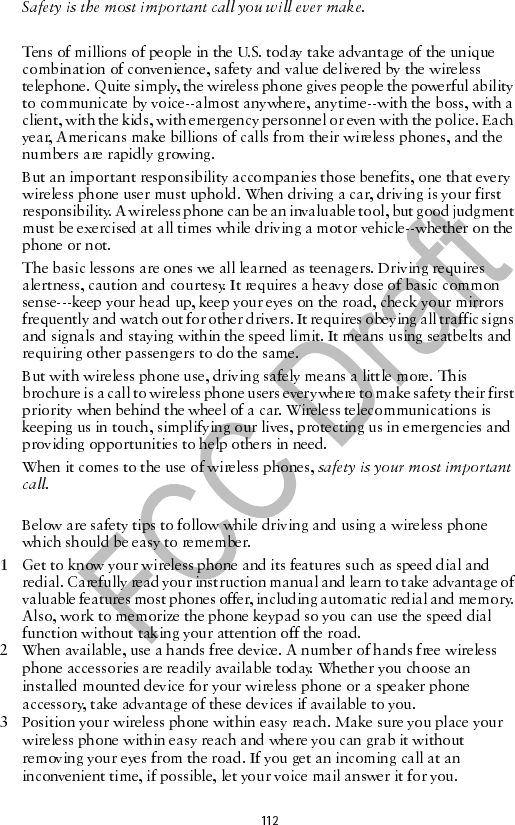
A Guide to Safe and Responsible Wireless Phone Use
Wireless Phone "Safety Tips"
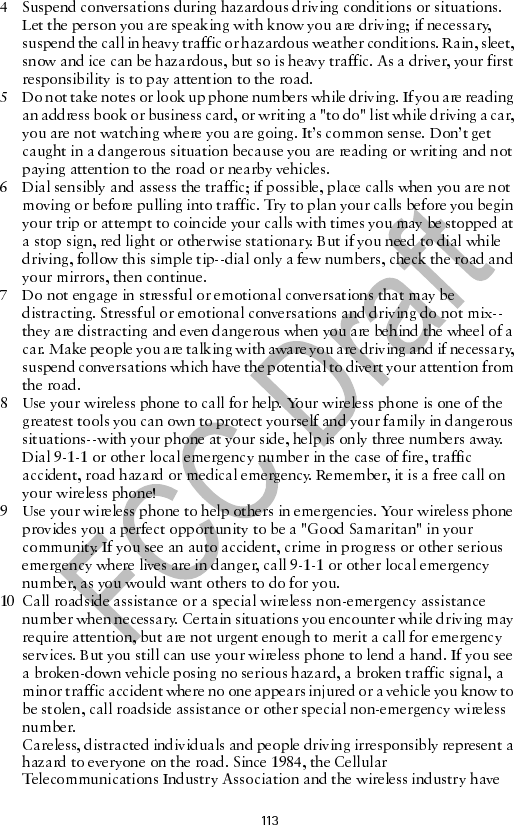
Appendix A Message from the CTIA
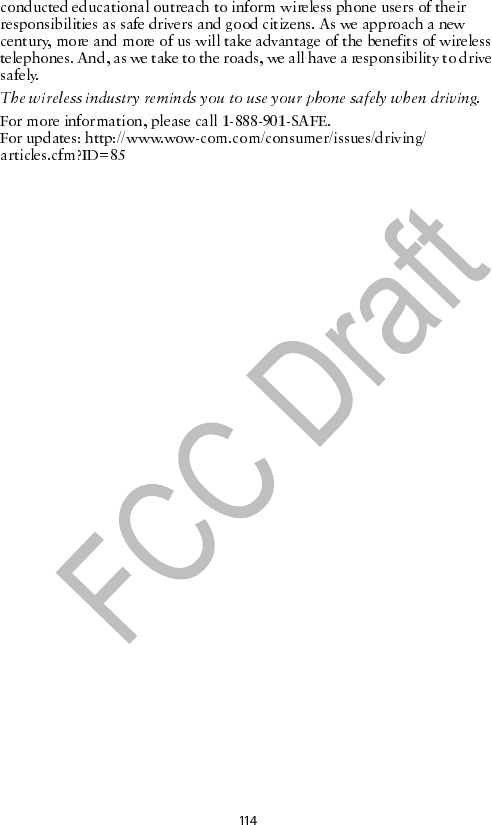

Appendix B Message from the FDA
Appendix B Message from the FDA
(U.S. Food and Drug Administration) to all
users of mobile phones
©July 18, 2001For updates: http://www.fda.gov/cdrh/phones
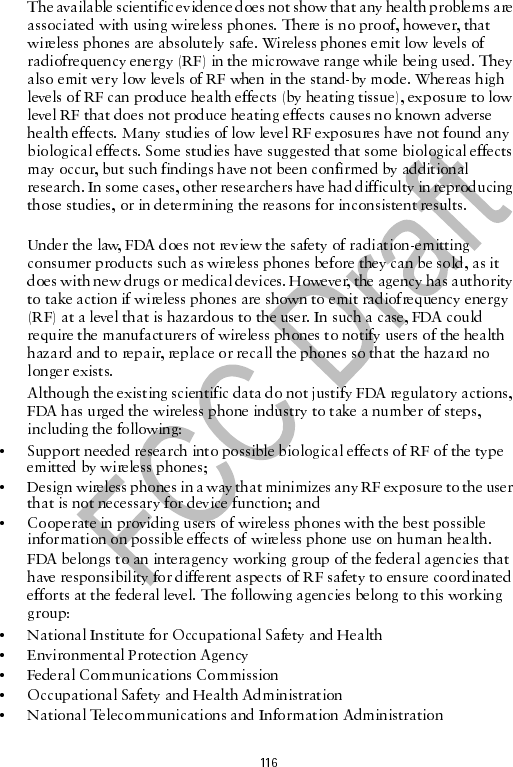
Consumer Update on Wireless Phones
U.S. Food and Drug Administration
1. Do wireless phones pose a health hazard?
2. What is FDA’s role concerning the safety of wireless phones?
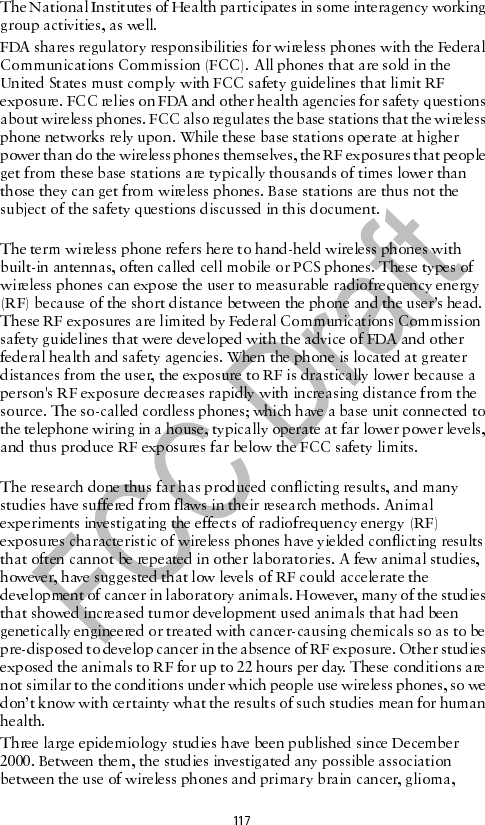
Appendix B Message from the FDA
3. What kinds of phones are the subject of this update?
4. What are the results of the research done already?
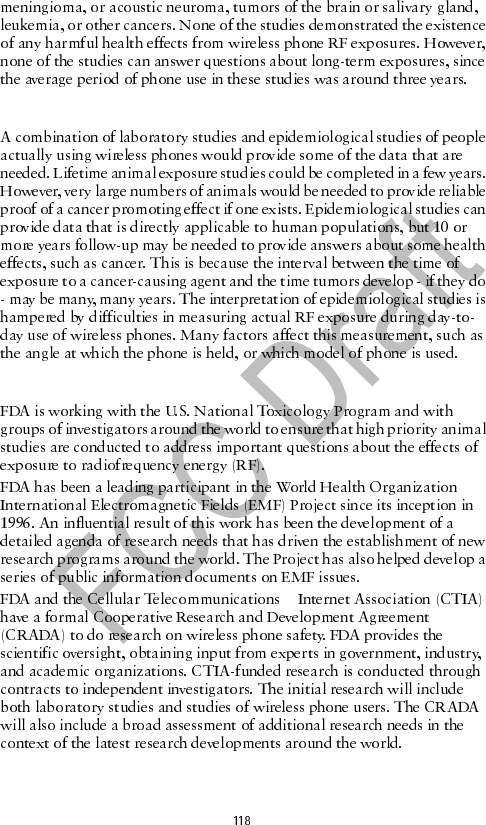
5. What research is needed to decide whether RF exposure from wireless
phones poses a health risk?
6. What is FDA doing to find out more about the possible health effects of
wireless phone RF?
&
7. How can I find out how much radiofrequency energy exposure I can get by
using my wireless phone?
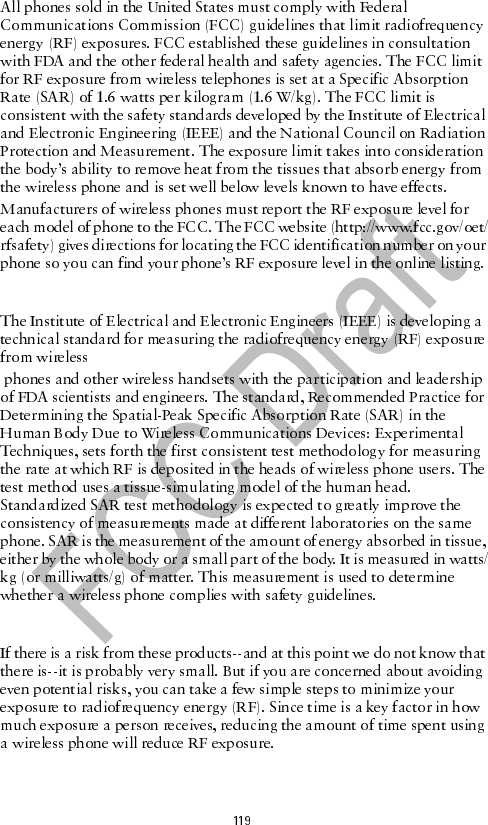
Appendix B Message from the FDA
8. What has FDA done to measure the radiofrequency energy coming from
wireless phones?
9. What steps can I take to reduce my exposure to radiofrequency energy from
my wireless phone?
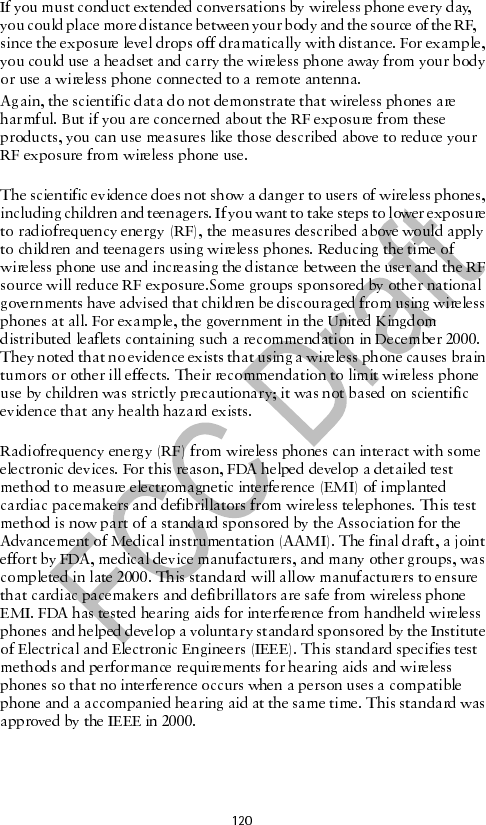
10. What about children using wireless phones?
11. What about wireless phone interference with medical equipment?
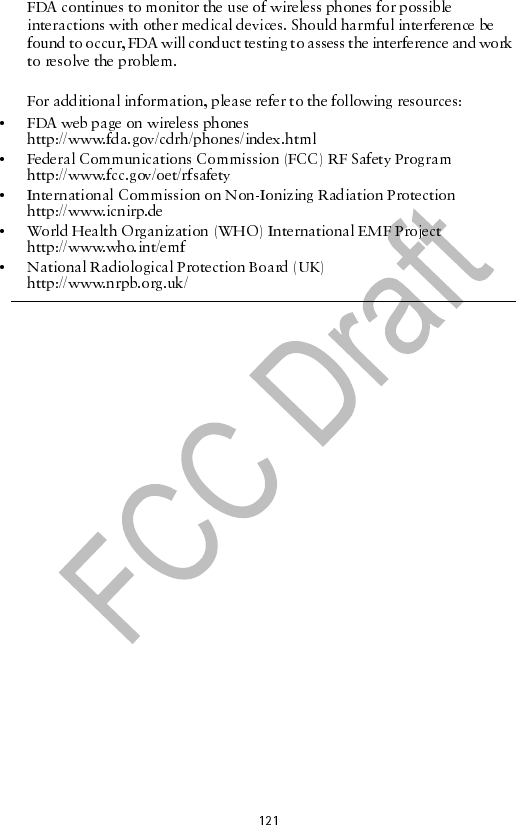
Appendix B Message from the FDA
12. Where can I find additional information?
July 18, 2001For updates: http://www.fda.gov/cdrh/phones


Nokia 7270 User Guide Copyright © 2004 Nokia
Numerics
1-touch dialing 44, 56
A
accessibility 11
activate call forwarding 54
alarm clock 70
answer a call 19
anykey answer 55
applications menu 84
availability 39
B
battery 96
bookmarks 89
business cards 43
C
calculator 80
calendar 71
call
answer 19
forwarding 54
log 47
make 18
record 68
reject 19
restriction 59
waiting 56
caller
groups 46
ID 56
camera 64
clock radio 70
closed user groups 61
connection ports 96
connectivity
infrared 52
contacts 35
1-touch dialing 44
add image 38
business cards 43
call from 37
caller groups 46
copy 43
delete 38
find entry 37
memory 46
menu options 35
presence 38
save 35
search 37
select view 46
subscribed names 41
currency conversion 80
customer care 5
customize profile 48
D
data communication 54
date settings 50
definition of terms 105
delete
1-touch dialing entry 44
contact entry 38
fixed dialing entry 61
messages 26
voice tags 45
dialed numbers, view 47
dialing
1-touch 44
fixed 60

2 Copyright © 2004 Nokia
dictionary 22
display
language 57
settings 50
download
applications 86
games 84
E
e-mail 29
emergency calls
while online 91
with keys locked 18
enhancements 96
F
fixed dialing 60
folders
gallery 63
message 24
forward messages 26
G
gallery 63
games 84
glossary 105
GPRS mobile link 52
H
help text 58
I
IM 32
images
add to contacts 38
edit in gallery 64
info
message service 33
infrared connectivity 52
install SIM card 14
instant messages 32
Internet
options 91
security 92
service 87
K
keyguard 18
L
language 57
lap timer 81
M
make a call 18
media 64
camera 64
player 66
radio 67
voice recorder 68
menus 12
message alert tone 48
messages
delete 26
e-mail 29
folders 24, 30
forward 26
info message service 33
instant 32
linked 23
multimedia 26
read 25
reply 25
send 24, 28, 30
service commands 33

Nokia 7270 User Guide Copyright © 2004 Nokia
settings 24, 27, 29
text 24
voice 32
missed calls, view 47
mobile link 51
GPRS 52
multimedia messages 26
N
Nokia PC Suite 11
notes
calendar 72
to-do 73
O
organizer 70
alarm clock 70
calendar 71
to-do list 73
over the air settings 11
P
PC Suite 11
personal shortcuts 51
phone
memory 57
PIN code 59, 62
presence 38
presence status
change 39
profiles 48
PUK codes 63
Q
quick guide ii
R
radio 67
read messages 25
received calls, view 47
record
calls 68
video clip 65
voice tags 45
redial 56
registration 4
reject a call 19
reply to messages 25
restore factory settings 63
ringing tone 48
ringing volume 48
S
safety 1
security
code 62
mobile Internet 92
select profile 48
send
business card 44
caller ID 56
email 30
multimedia messages 28
text messages 24
service
commands 33
set
alarm clock 70
radio channel 67
time and date 50
settings 48
call 54
camera 65

4 Copyright © 2004 Nokia
display 50
enhancements 58
OTA 11
personal shortcuts 51
phone 57
presence 41
restore factory settings 63
security 59
time and date 50
tone 49
shortcuts
menu 13
personal 51
SIM card 14
speed dialing 44
stopwatch 81
subscribed names 41
summary after call 56
synchronization 74
T
text
entry 21
messages 24
time settings 50
timed profile 49
timer 82
to-do list 73
tones 48
turn off alarm clock 71
V
vibrating alert 48
video recorder 65
view
call lists 47
subscribed names 42
voice
dialing 44
messages 32
recorder 68
voice tags 45
change 45
volume, ringing tone 48
W
wallet 77
welcome note 57

04/04
Para obtener un manual del usuario en español favor de llamar o enviar
un fax al teléfono 1-888-NOKIA-2U, fax 813-249-9619.
9310640
1RNLD8VHU*XLGH